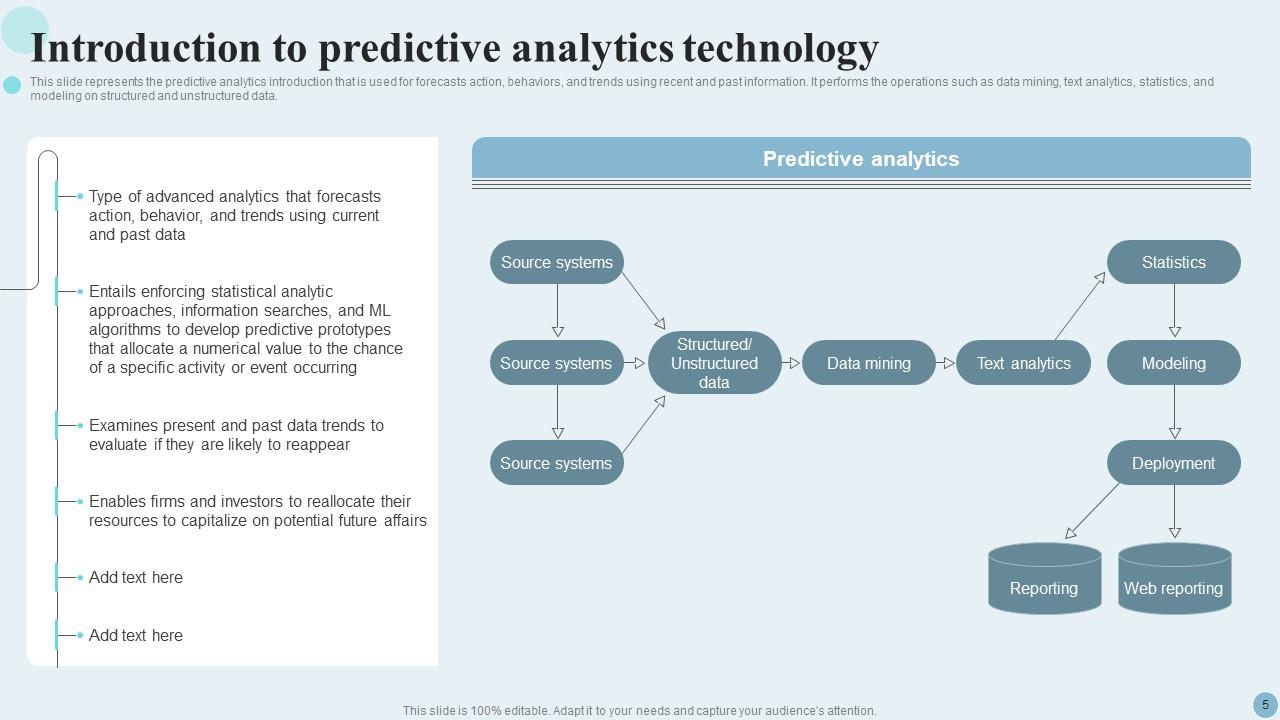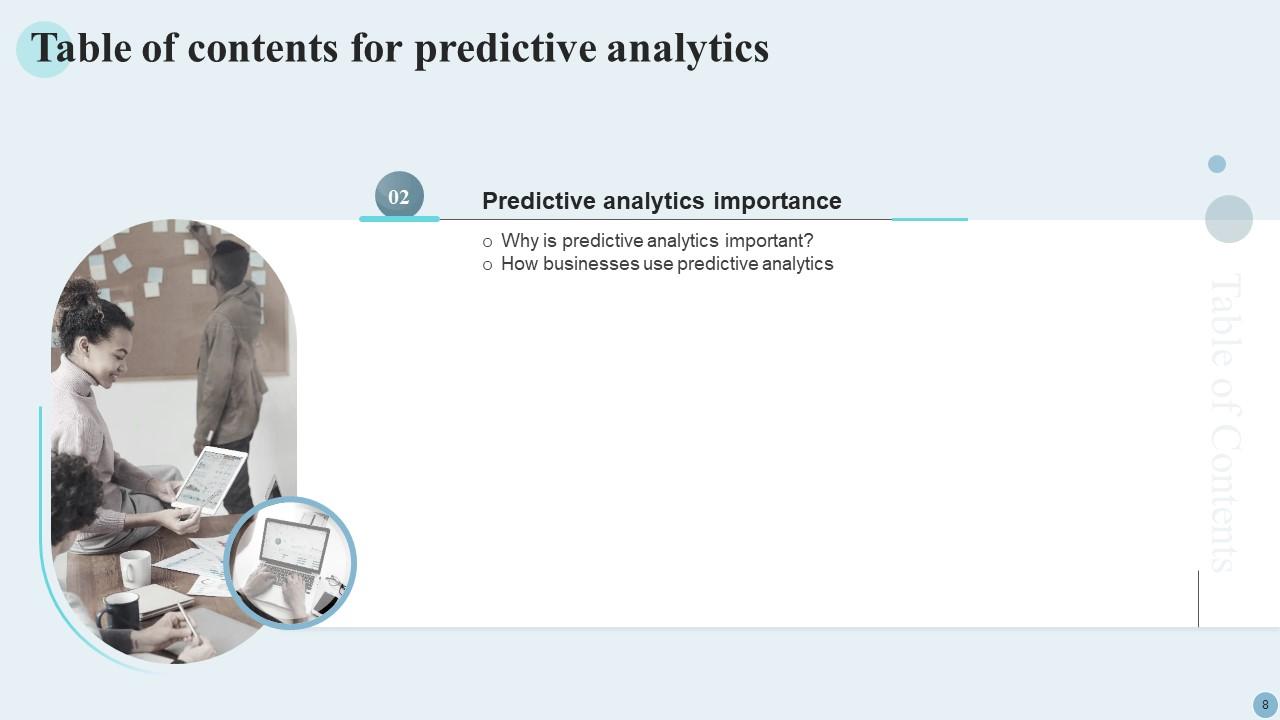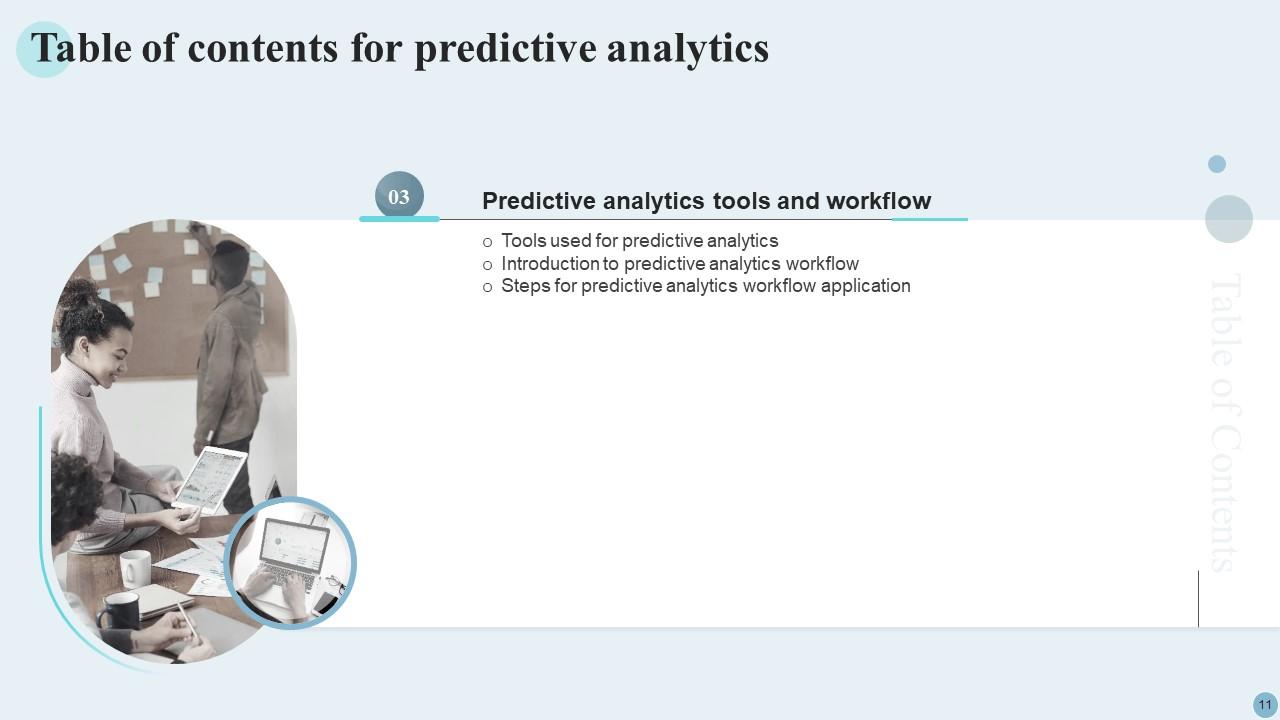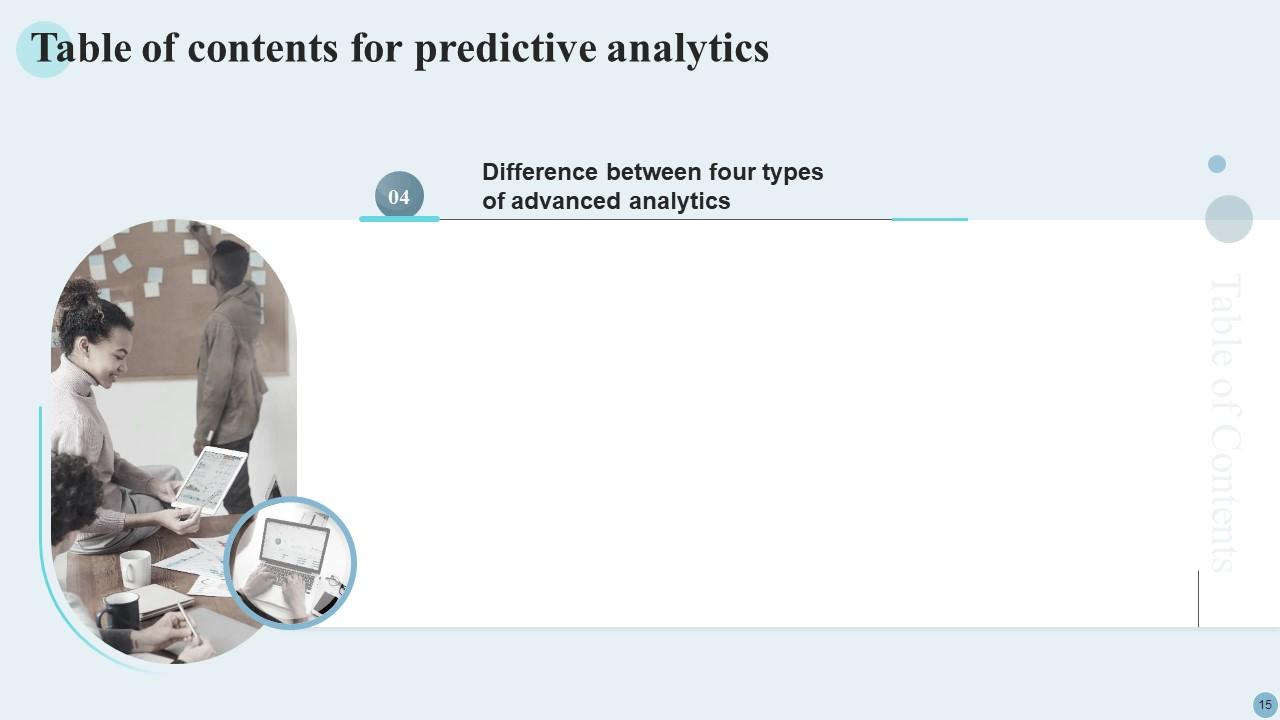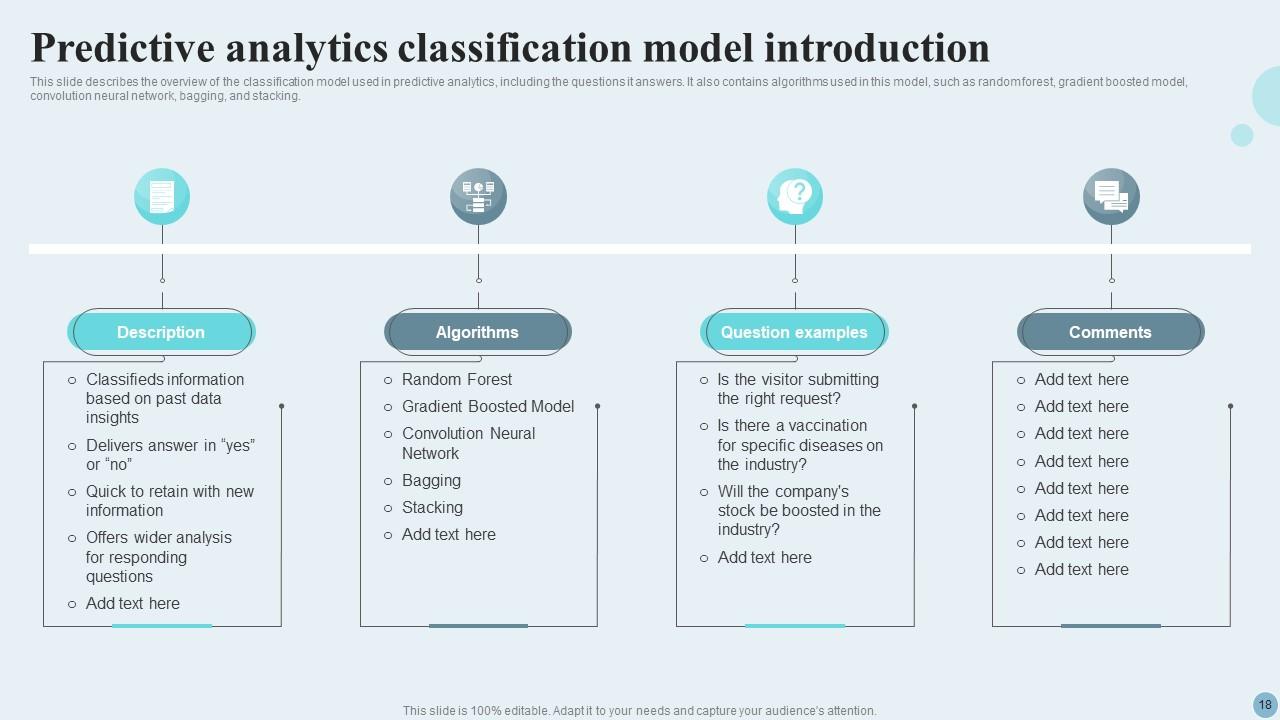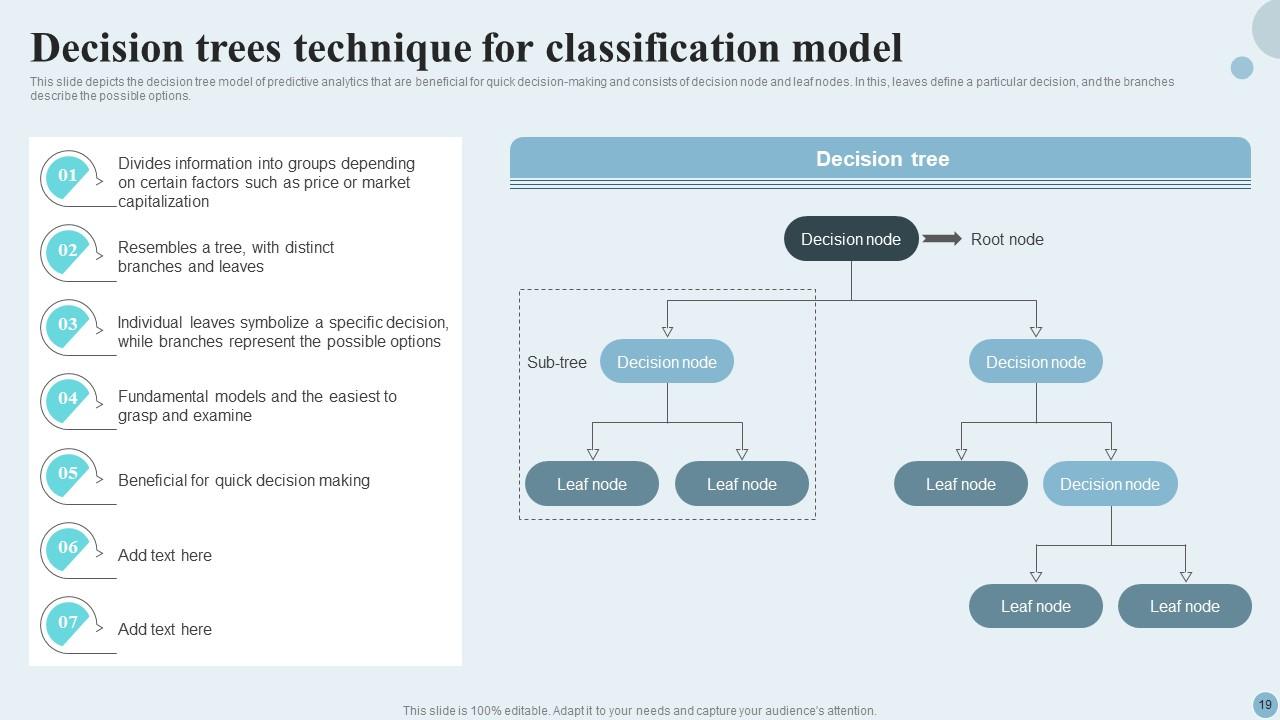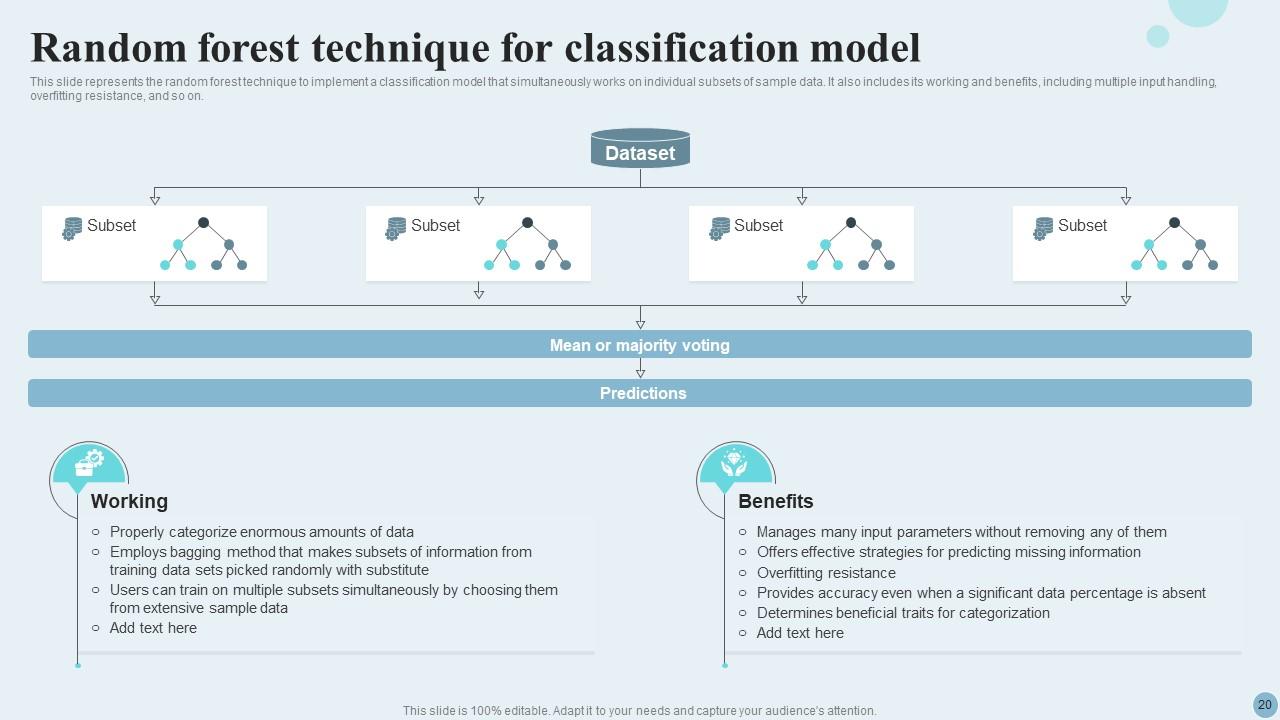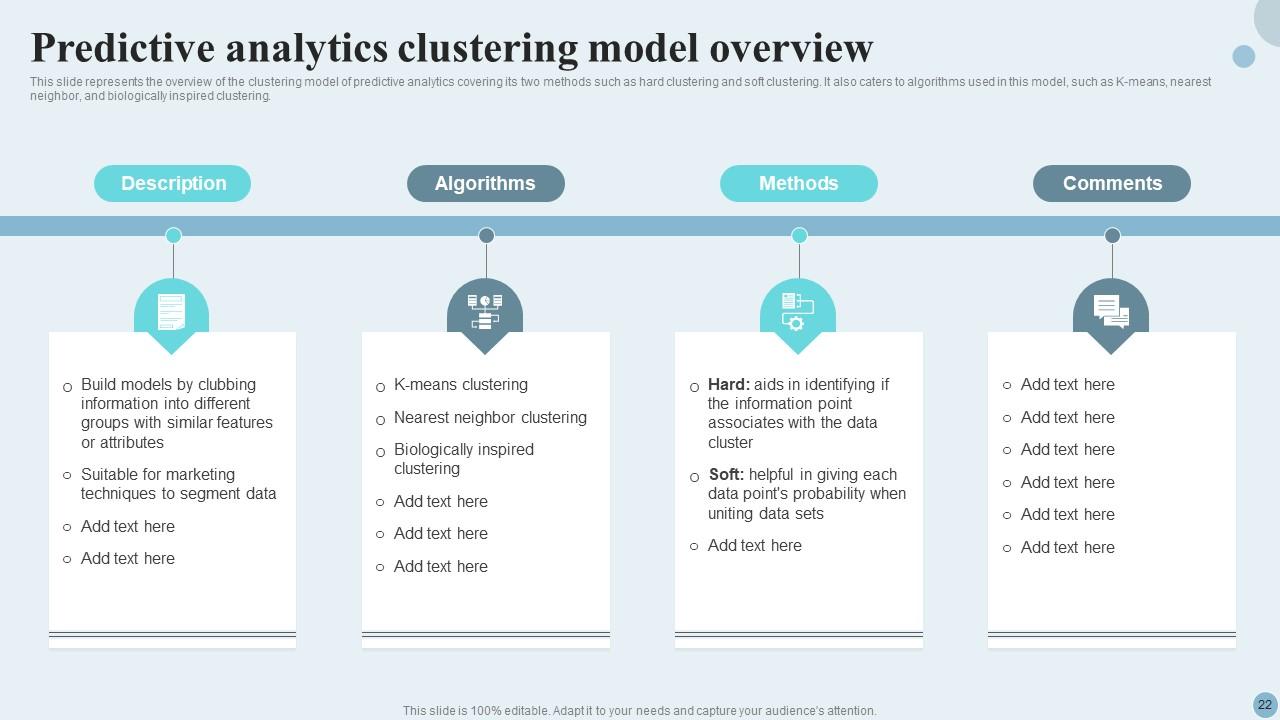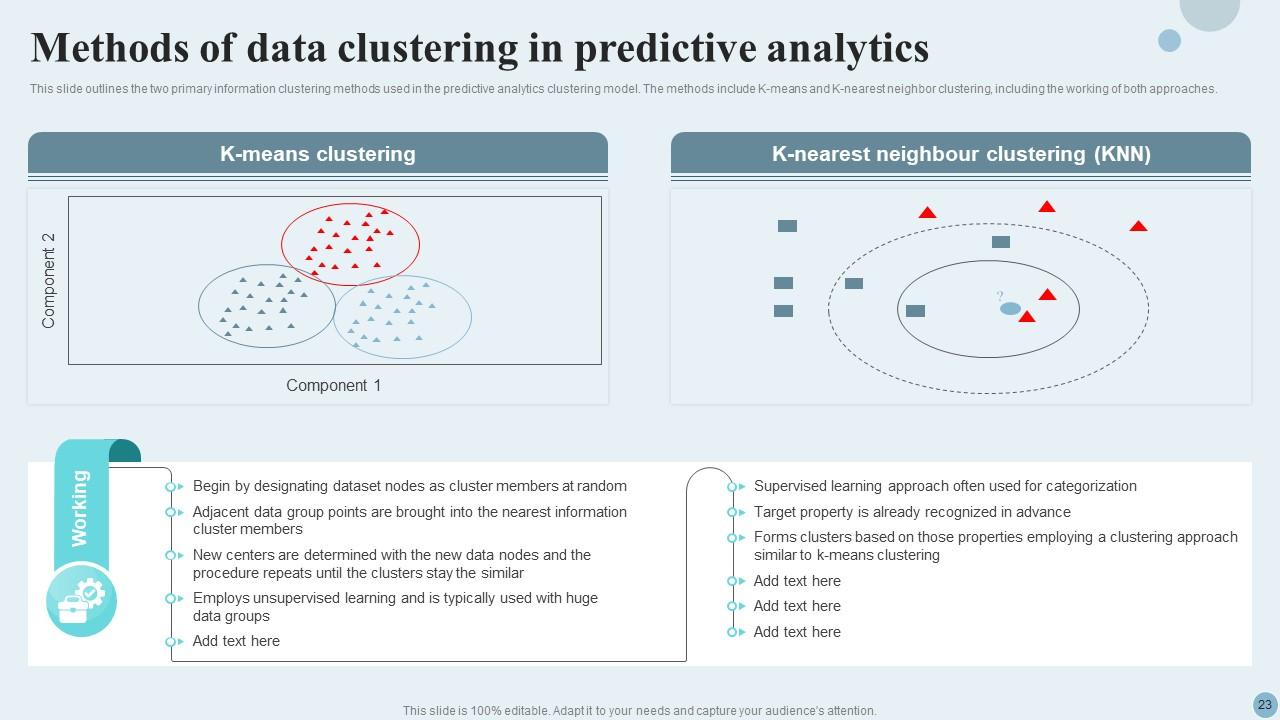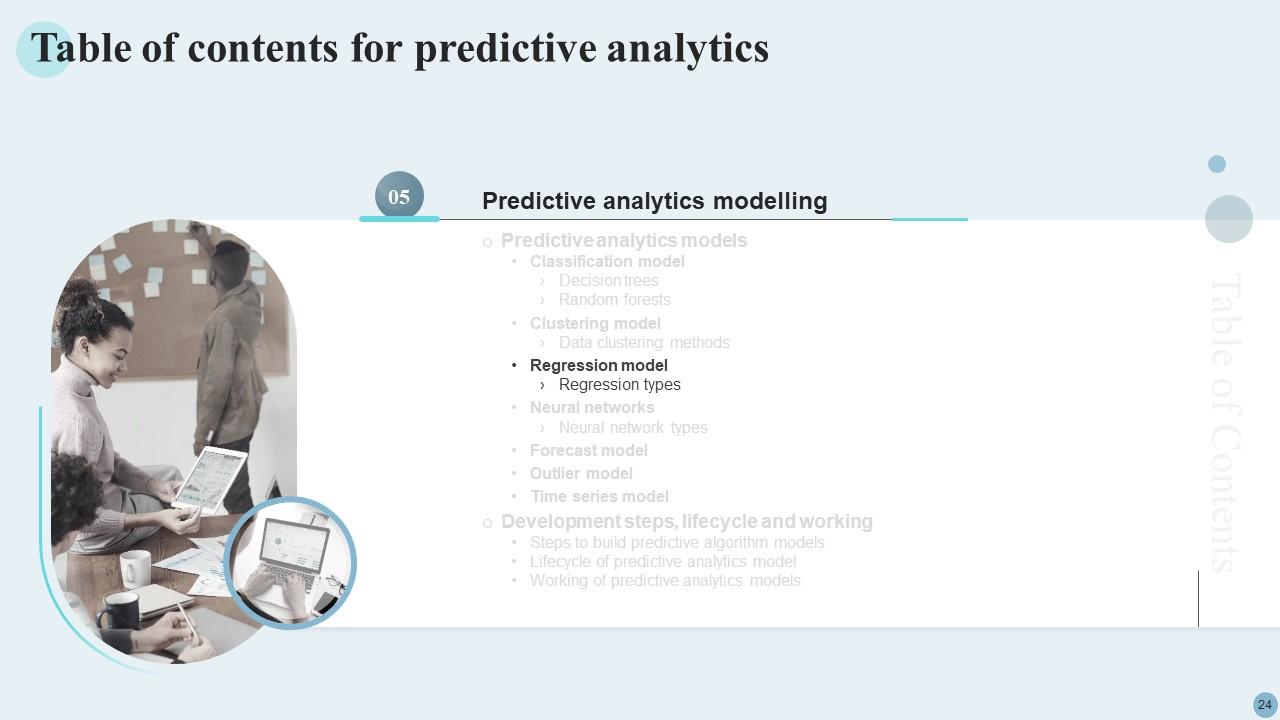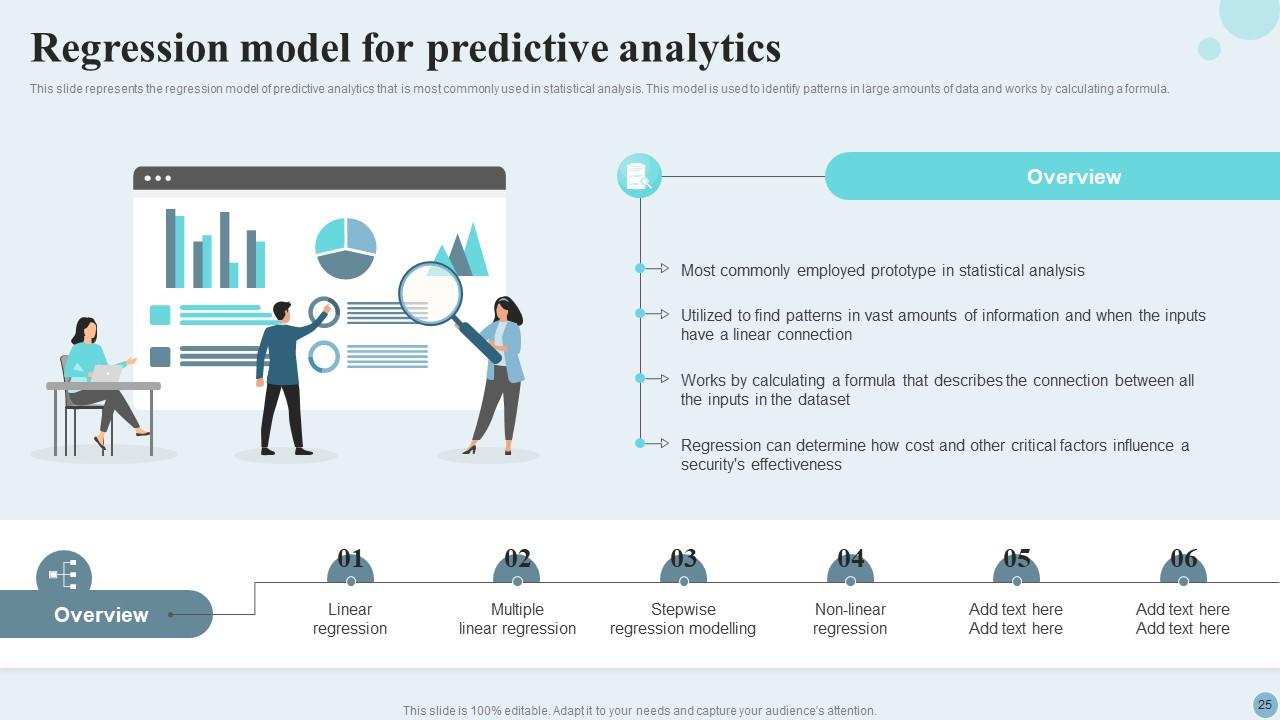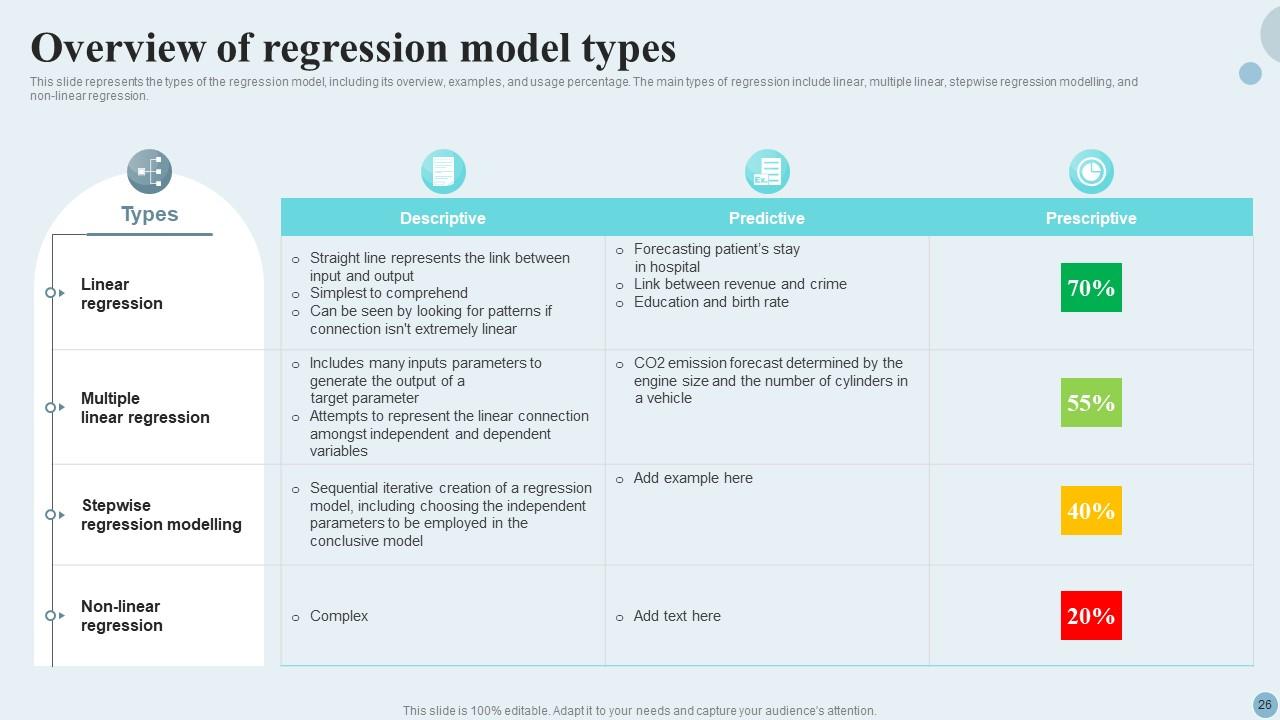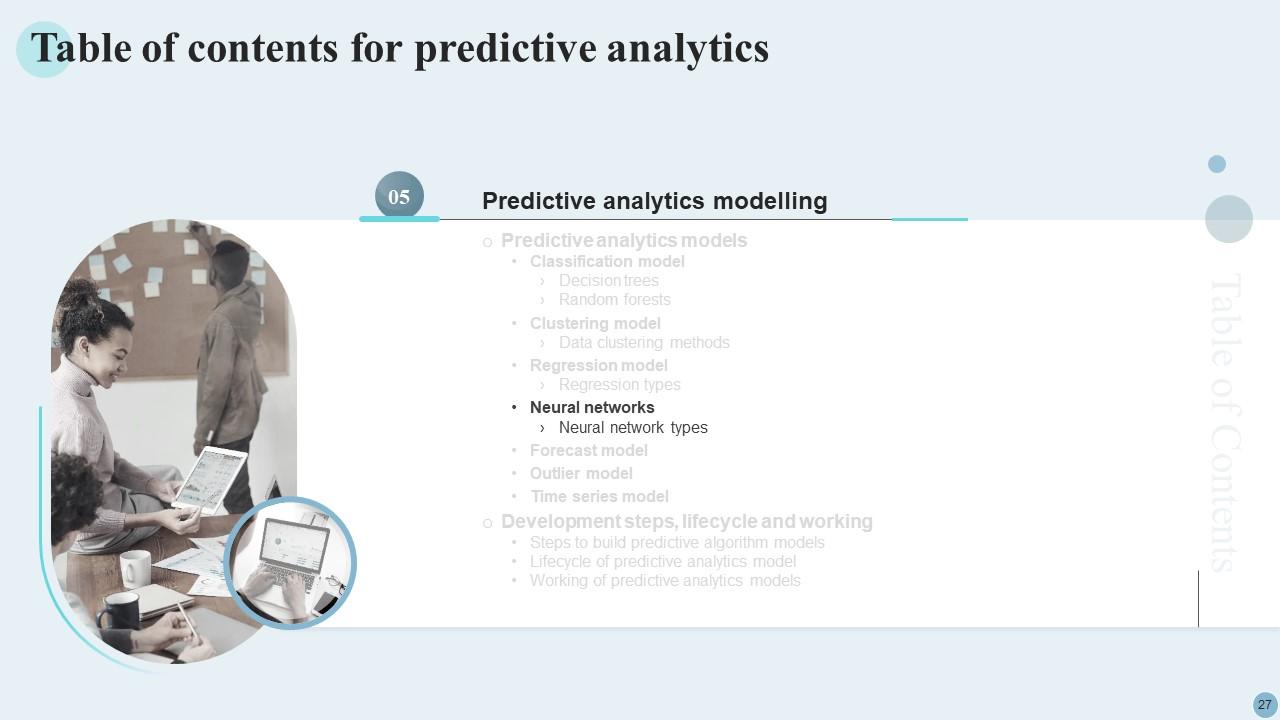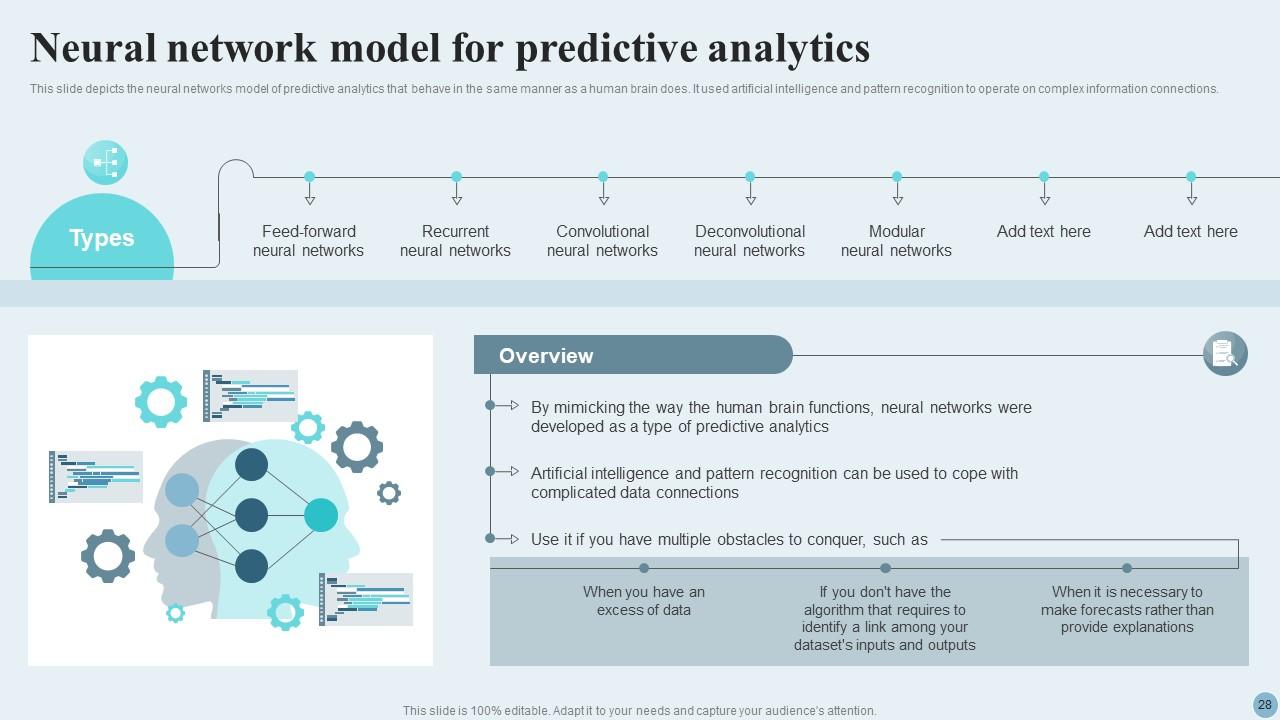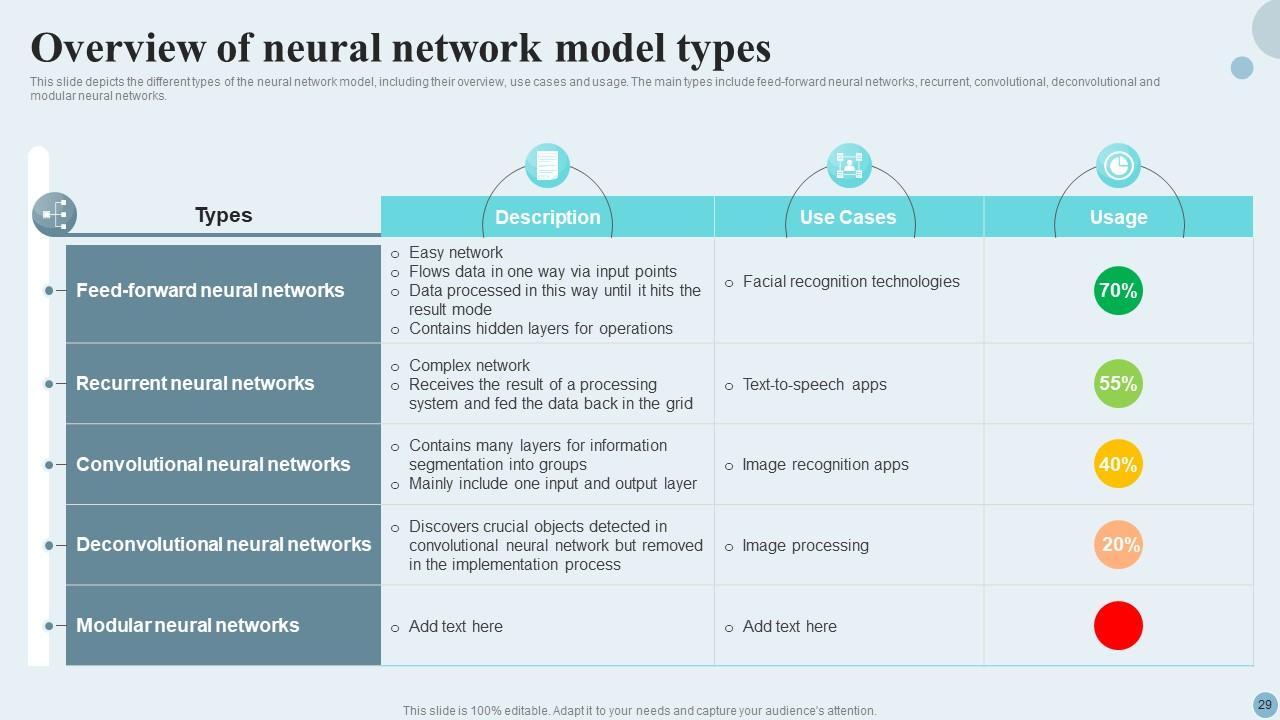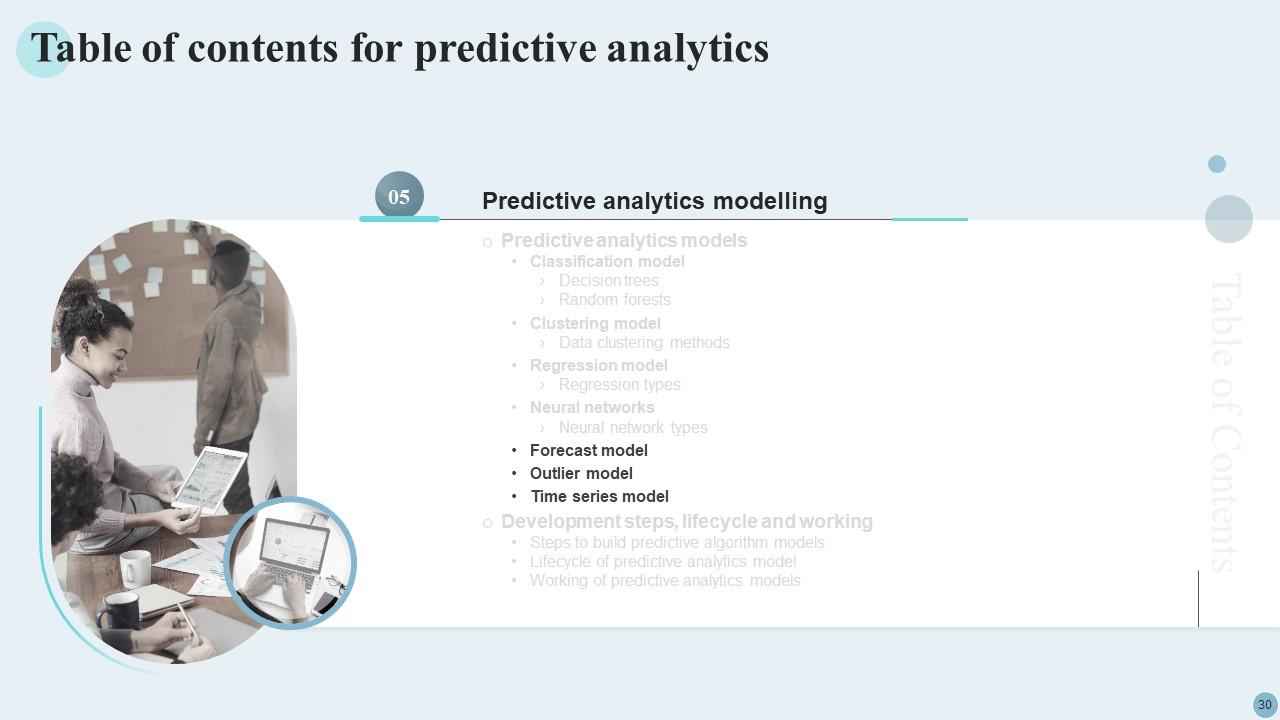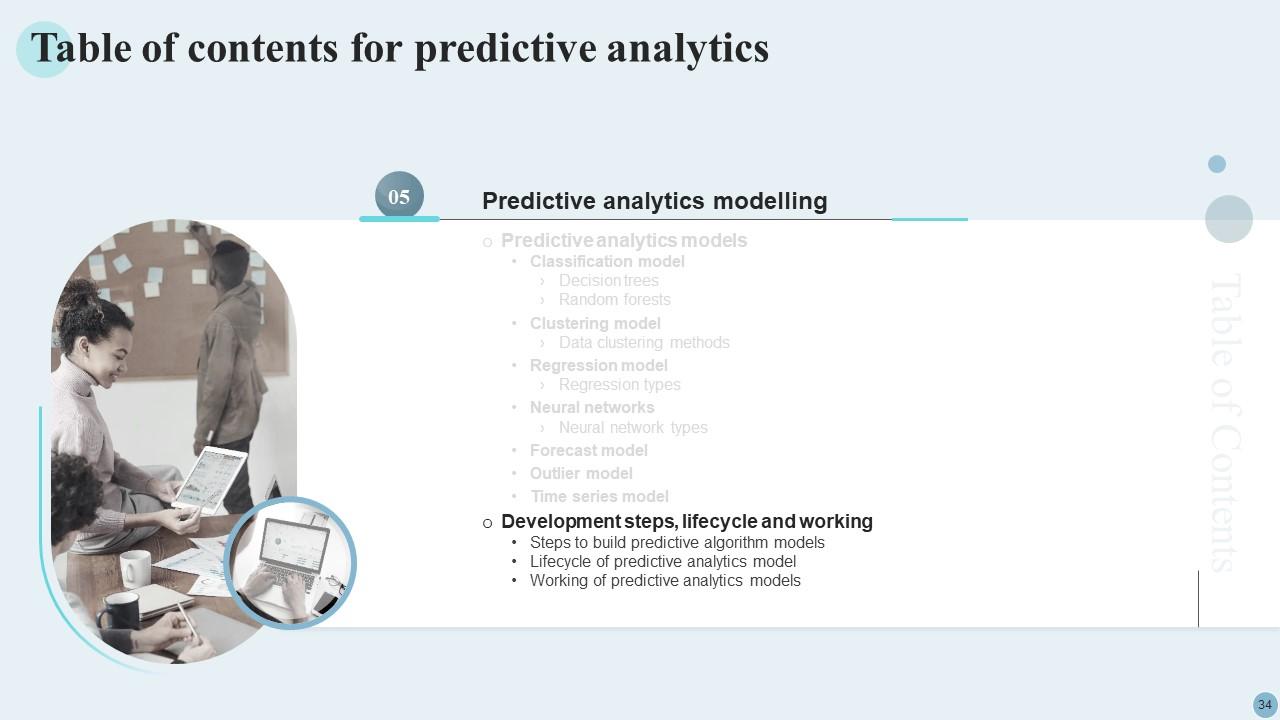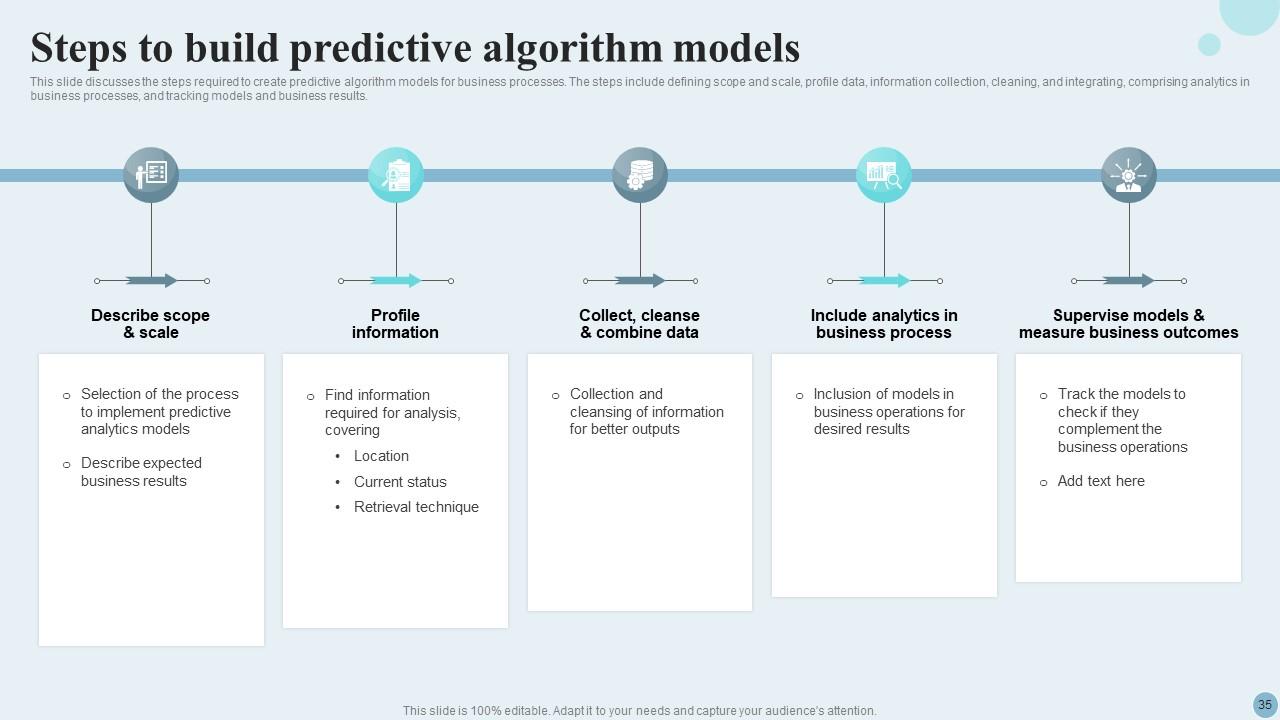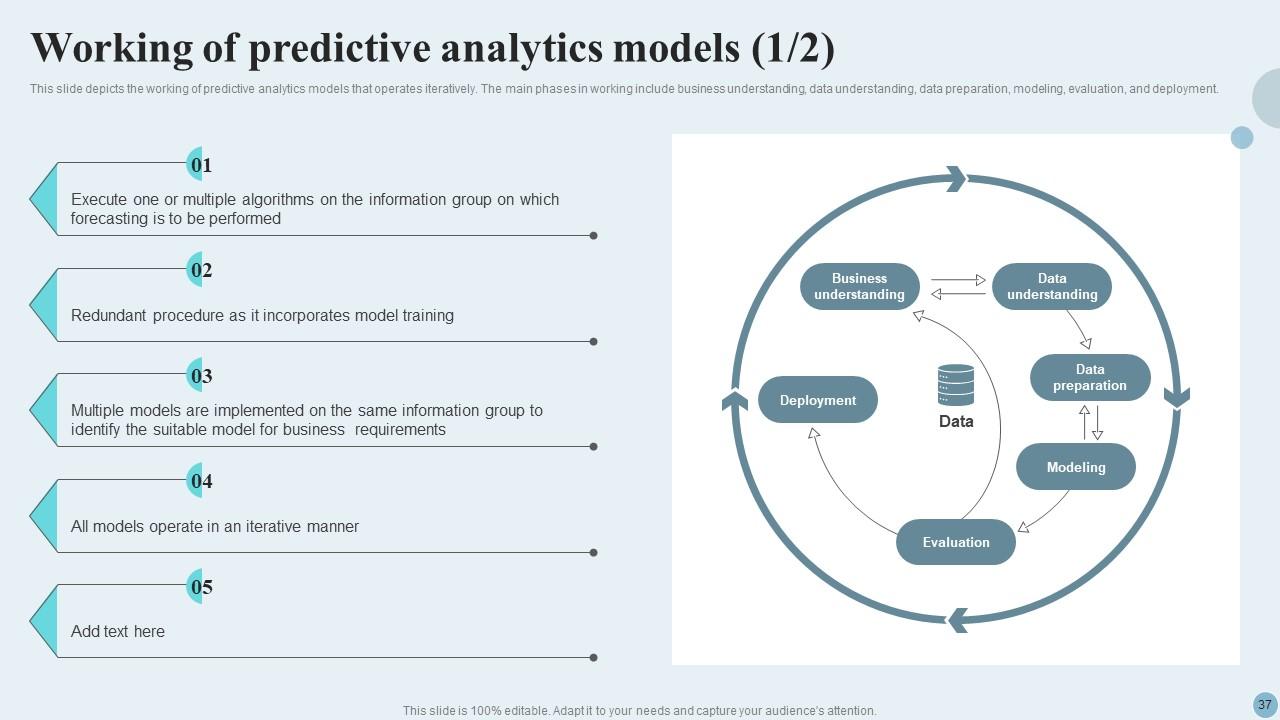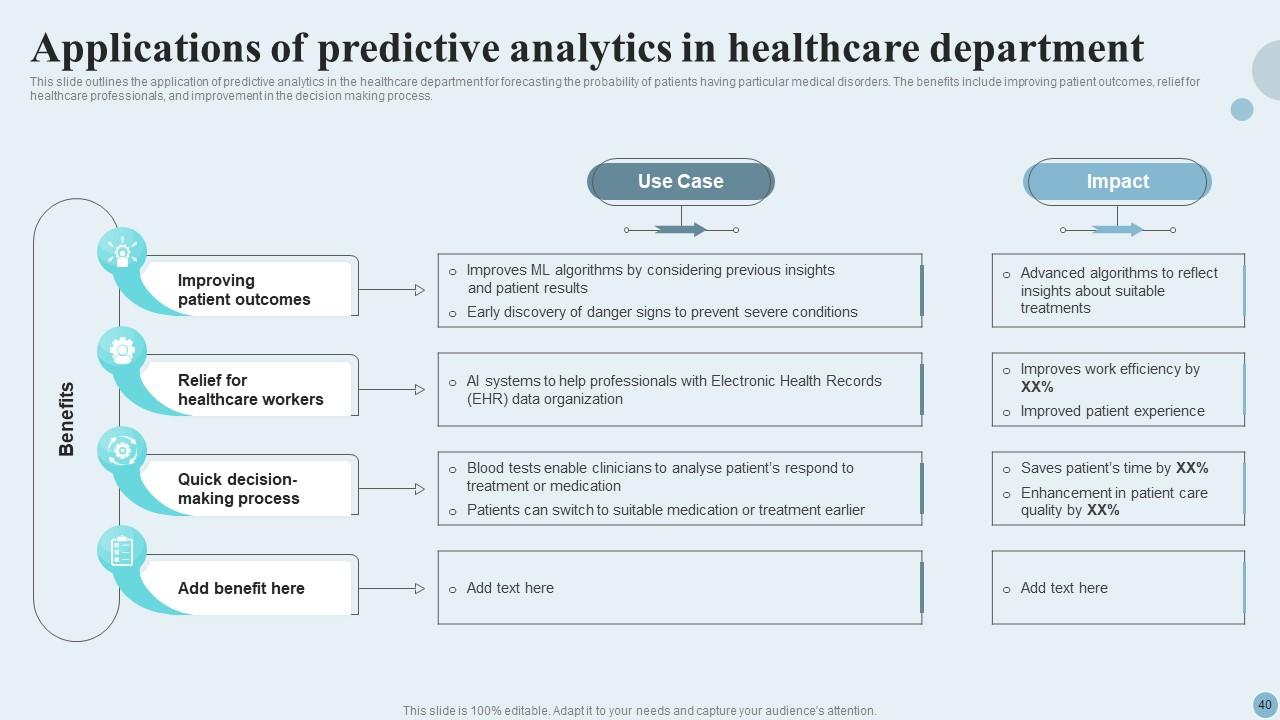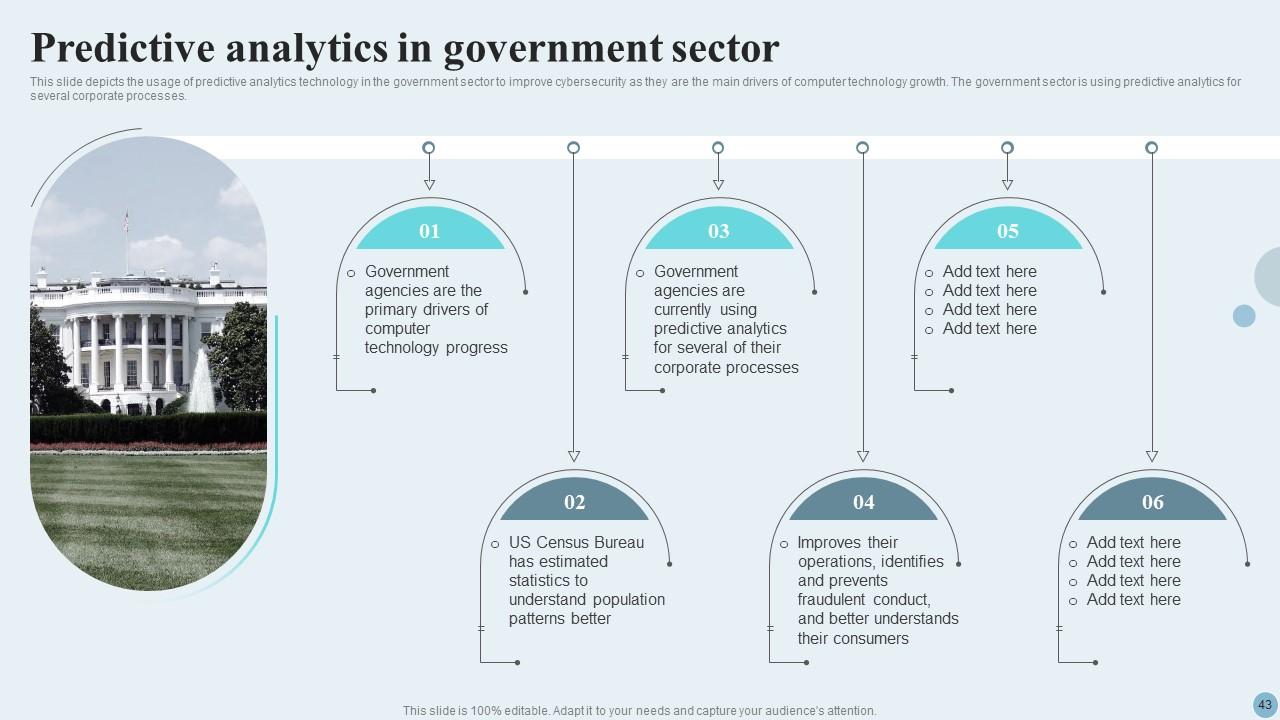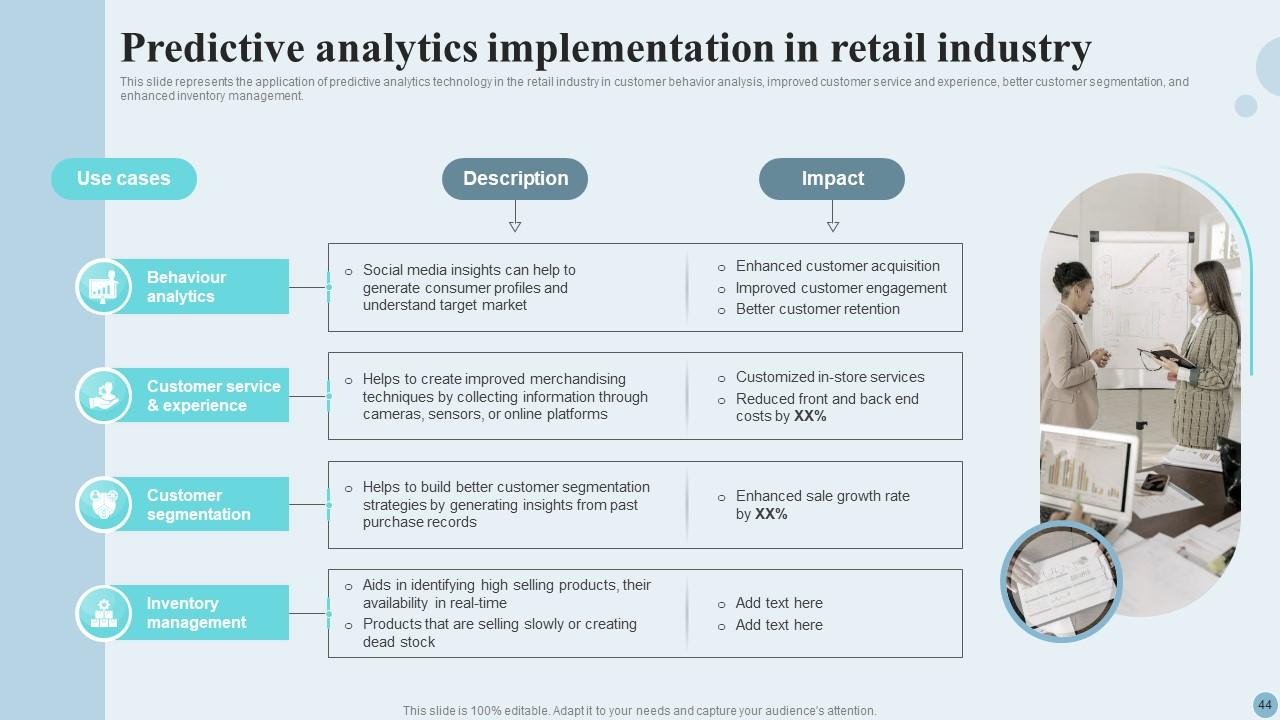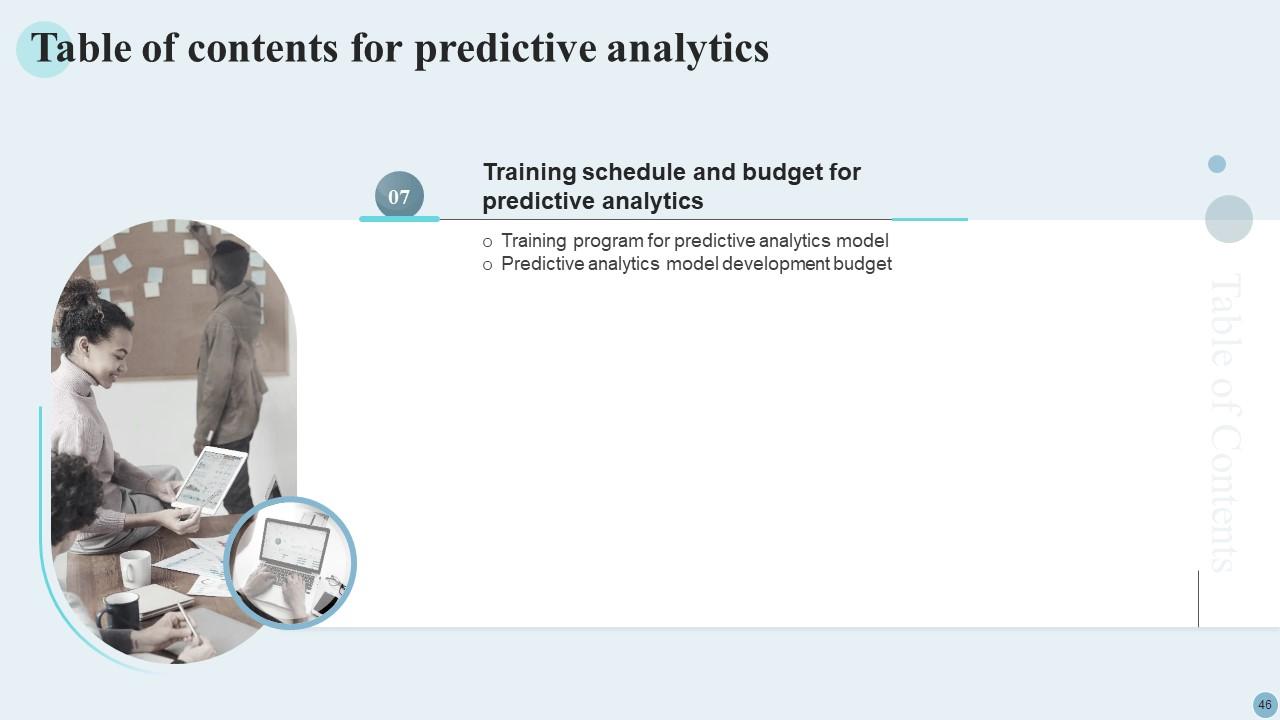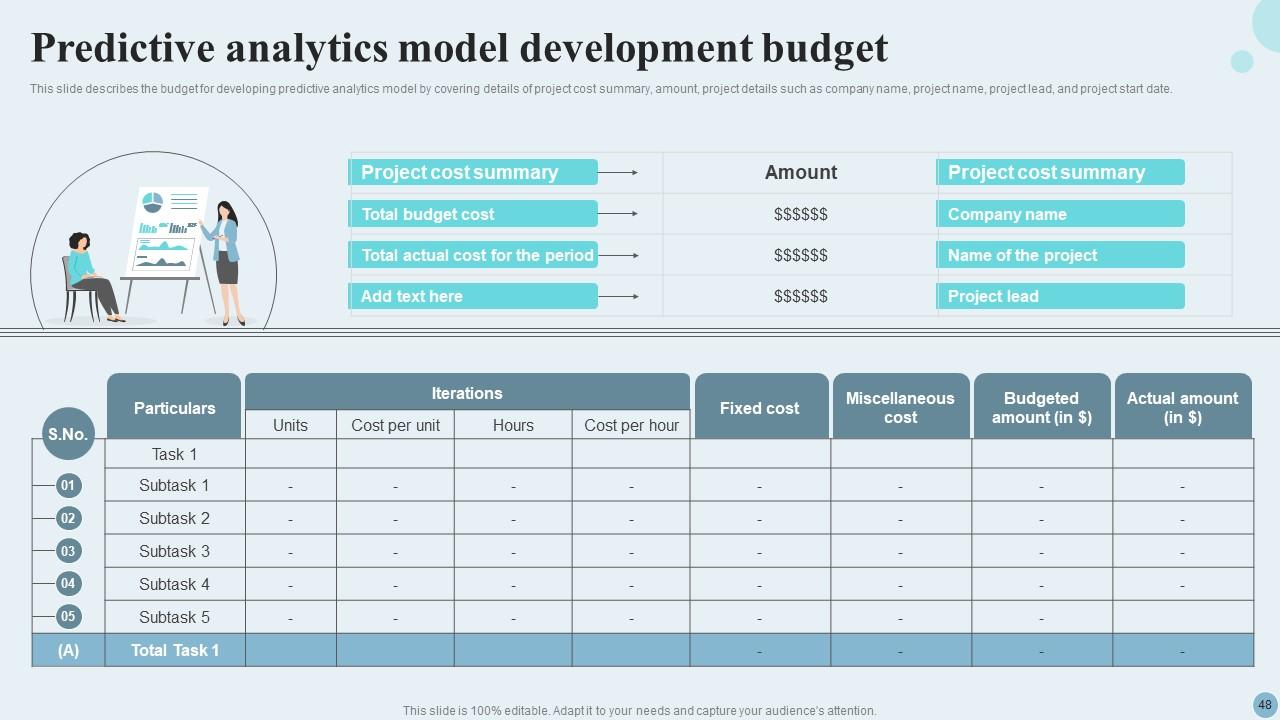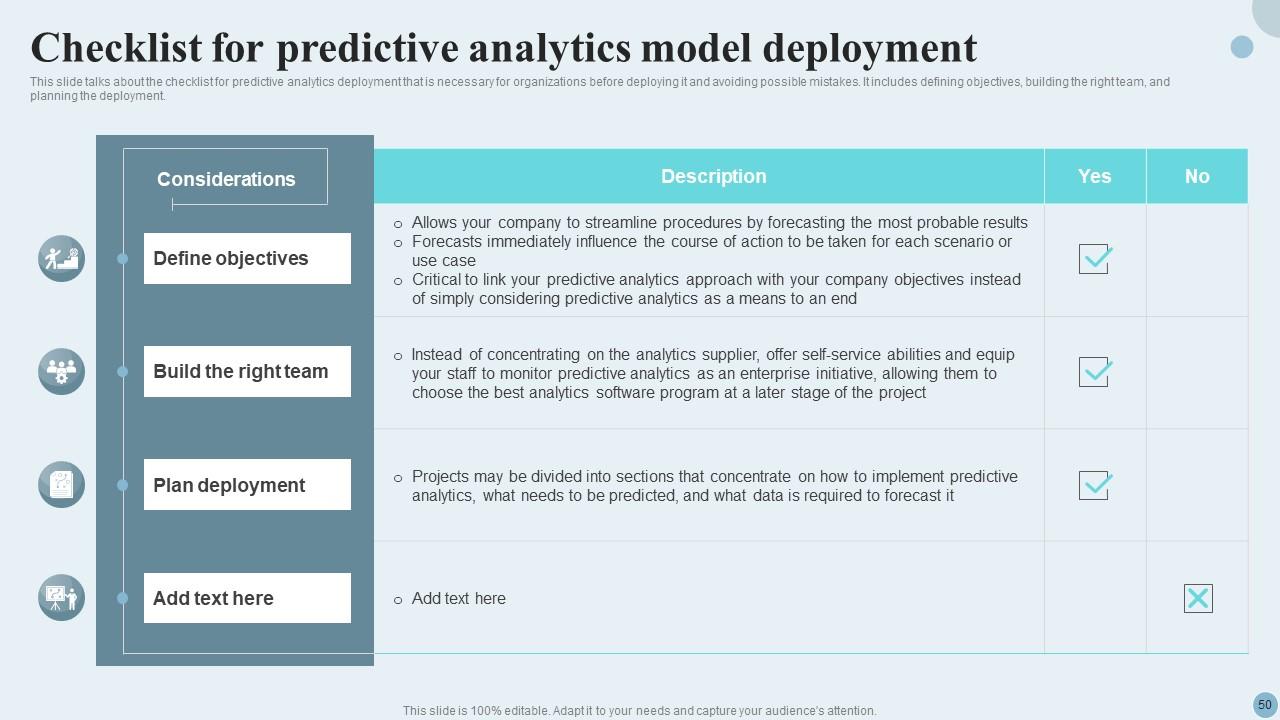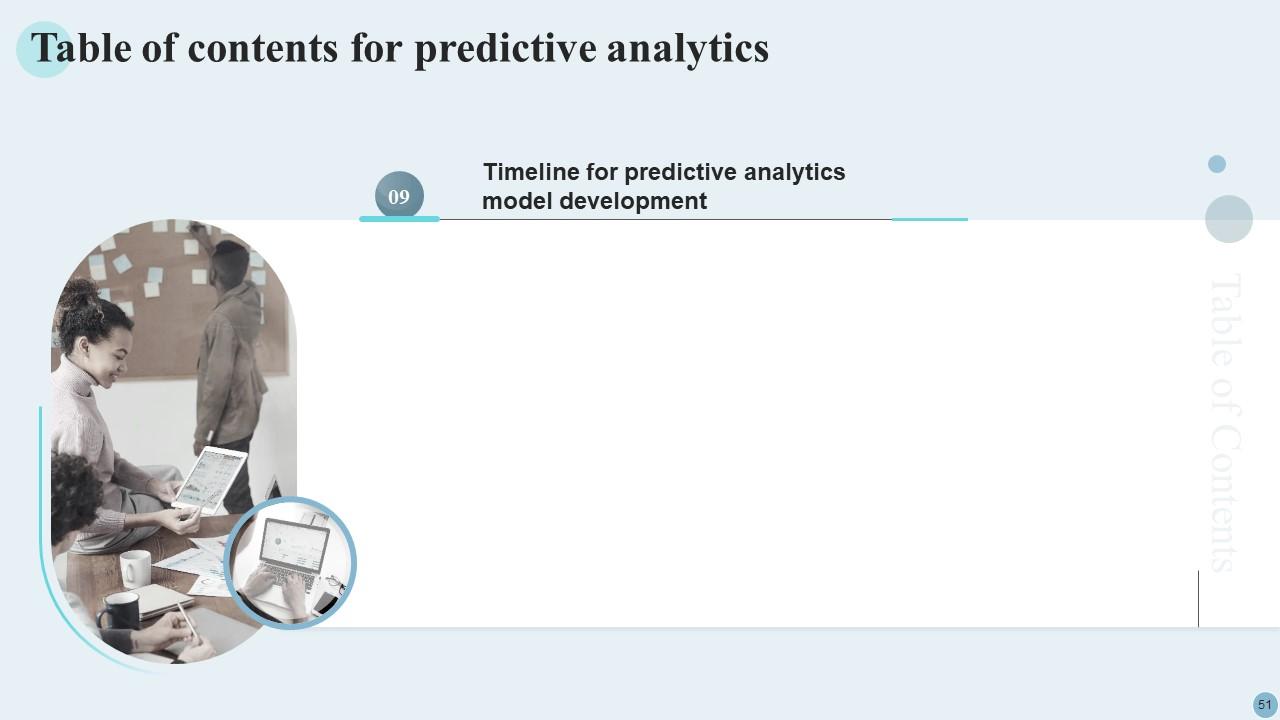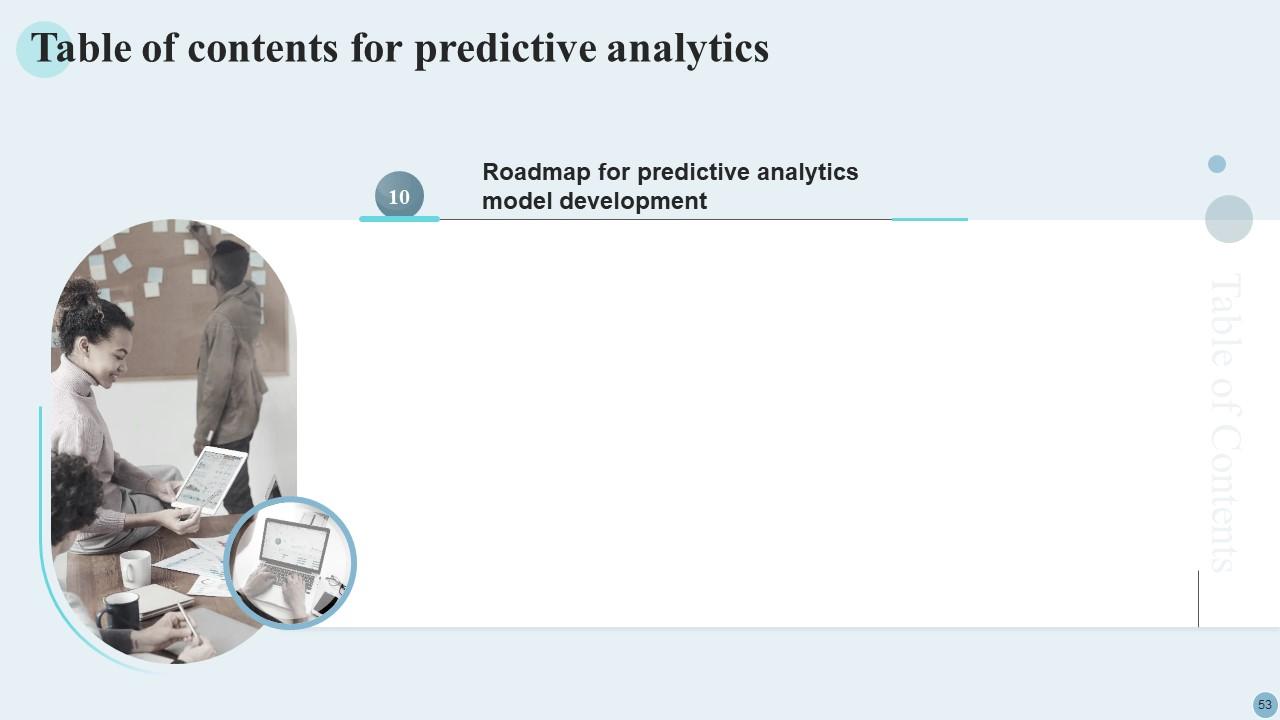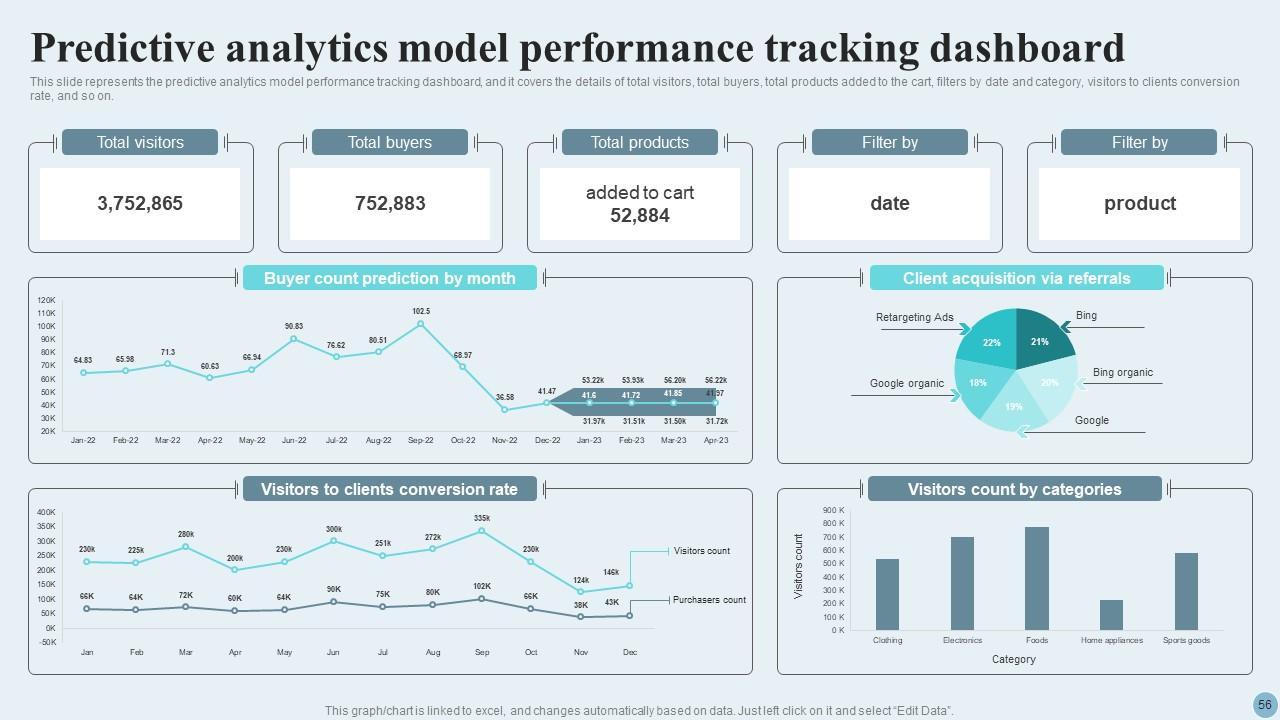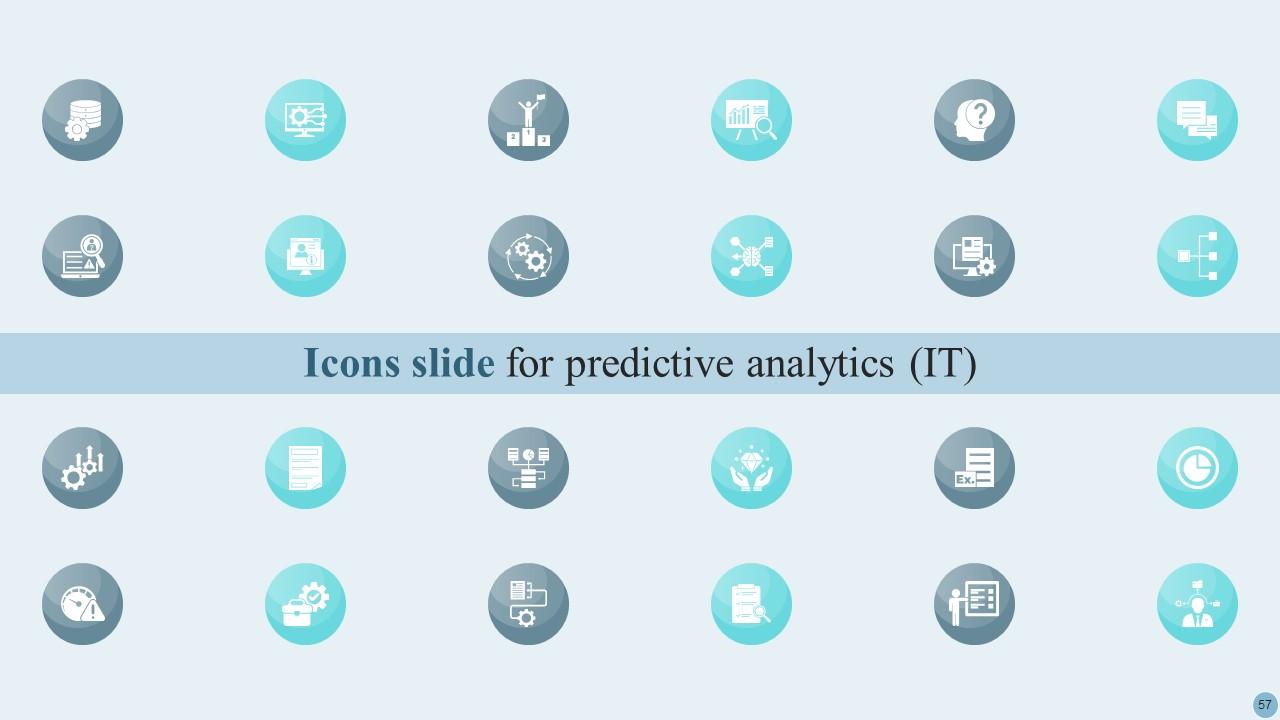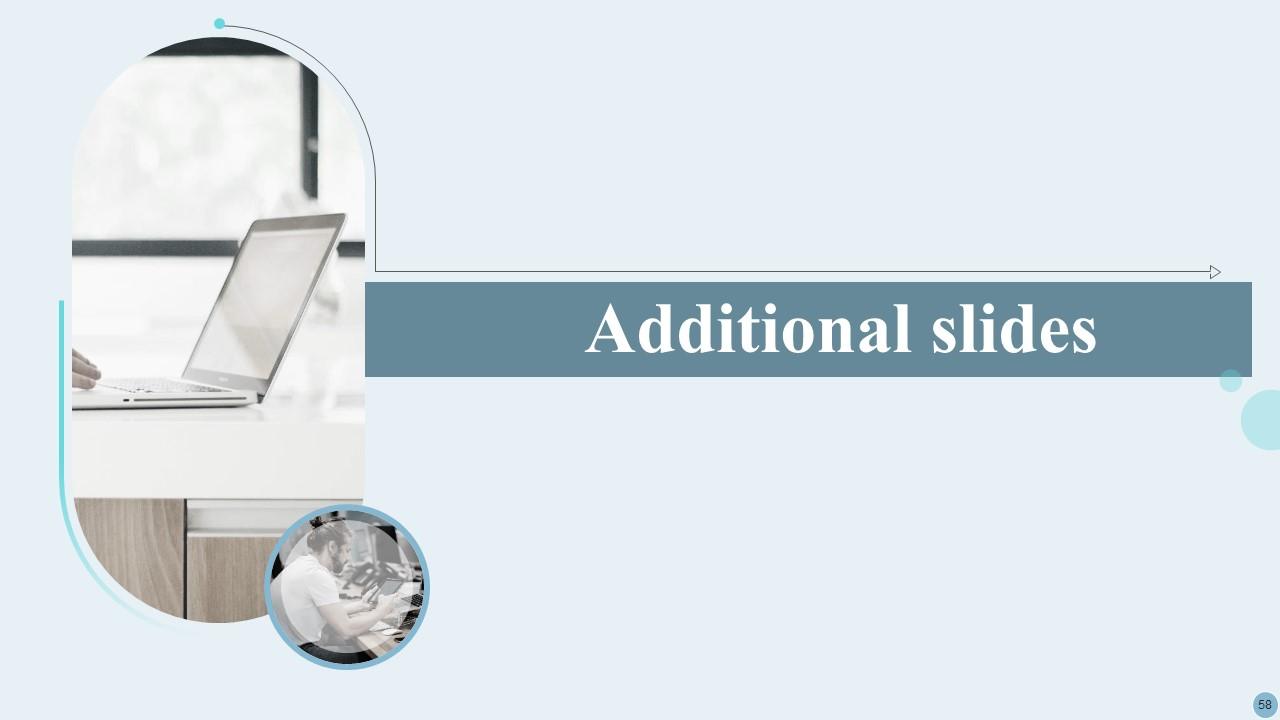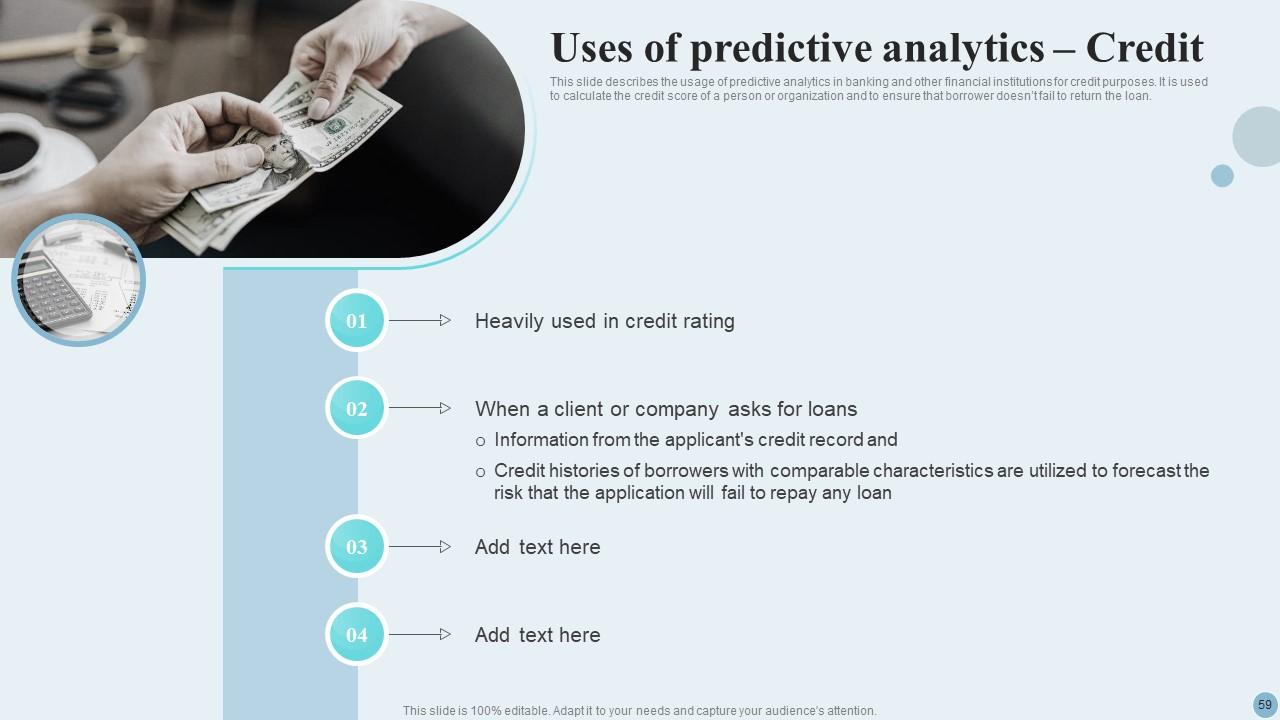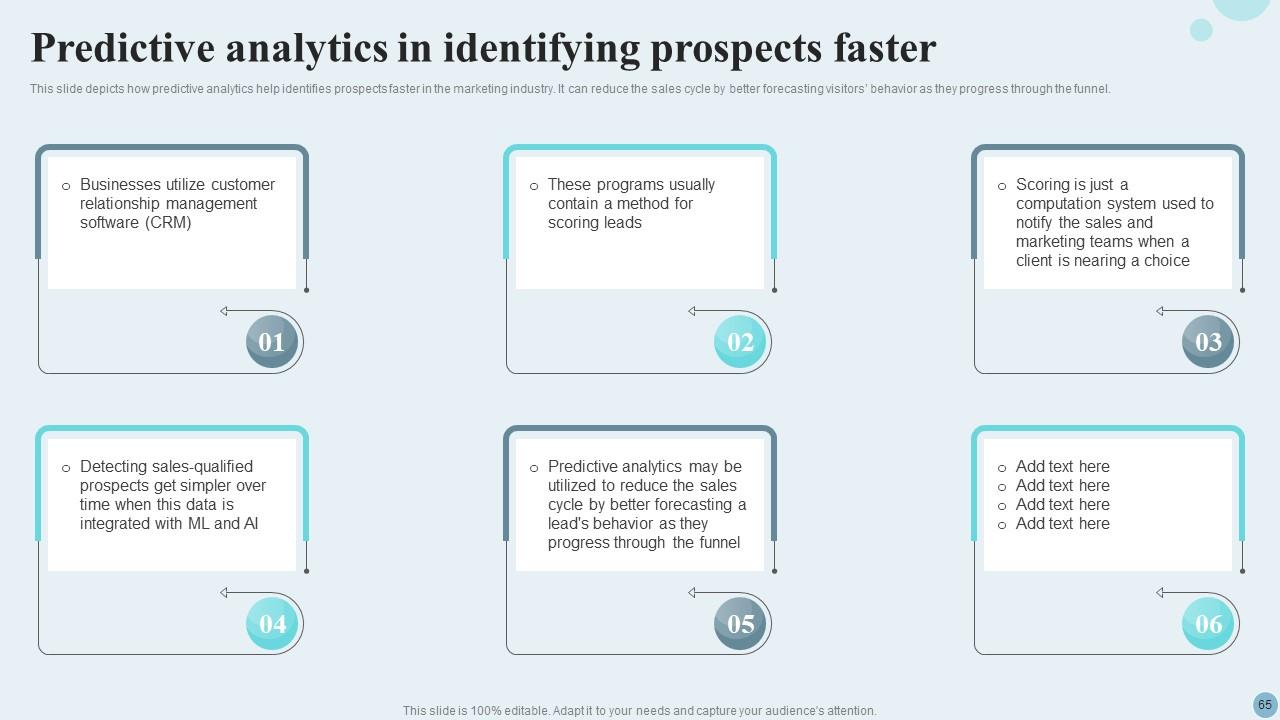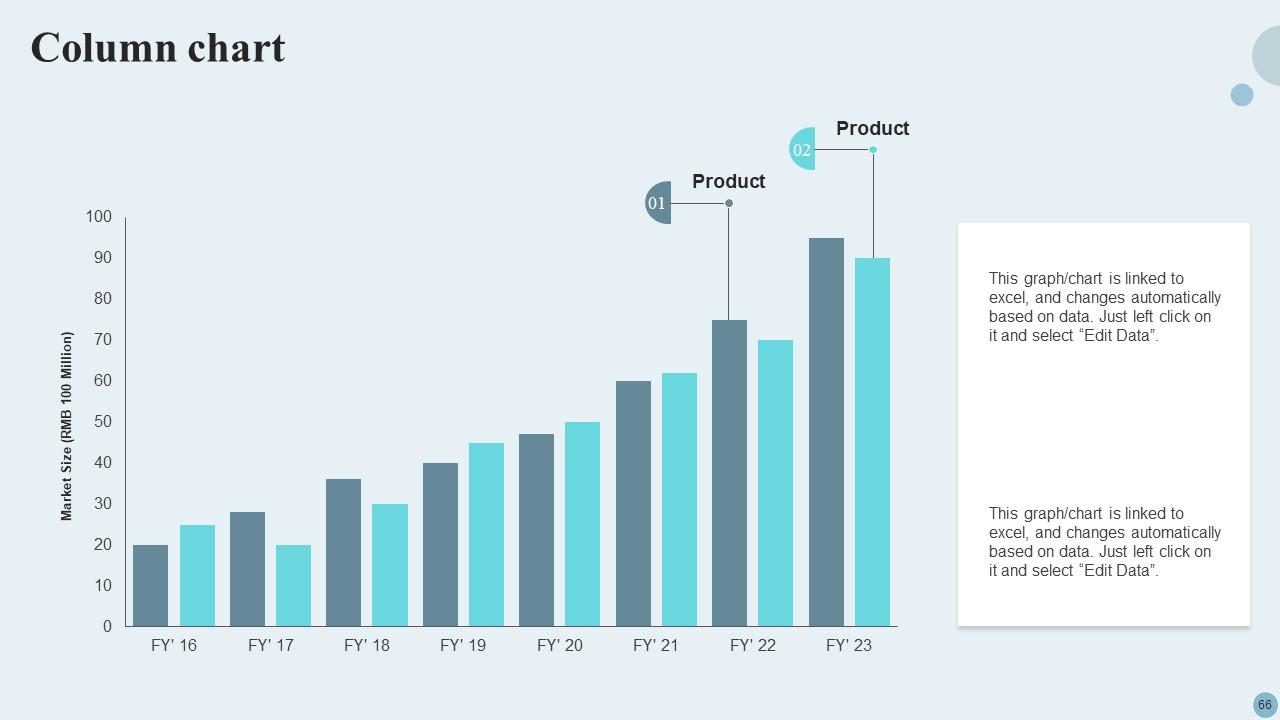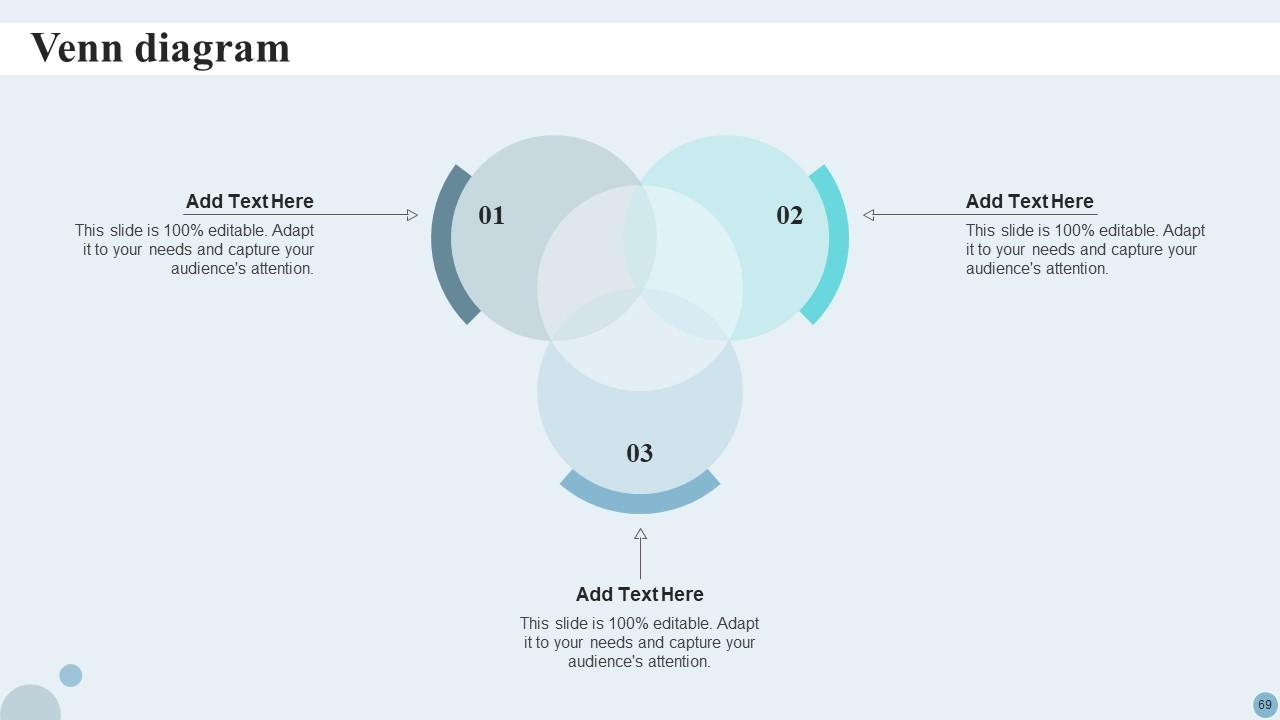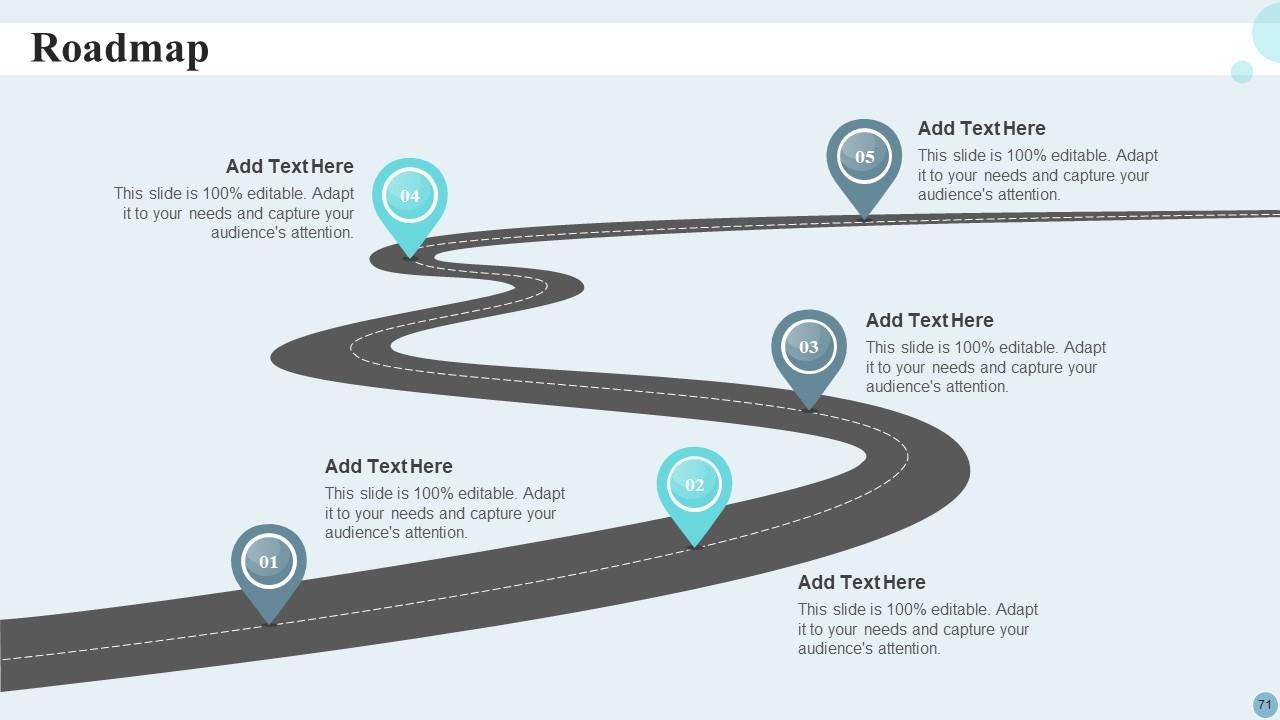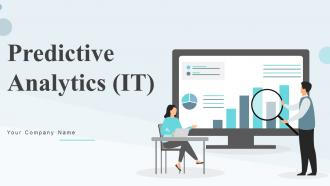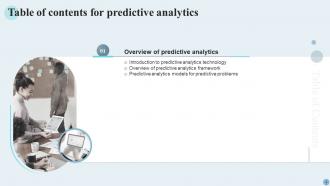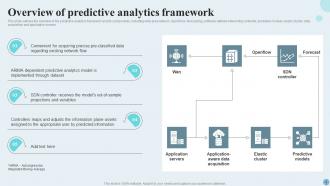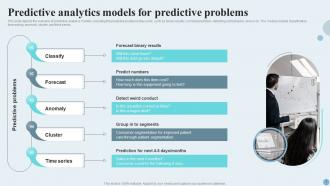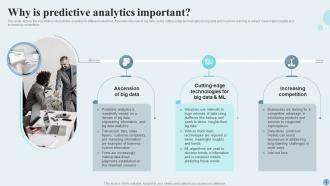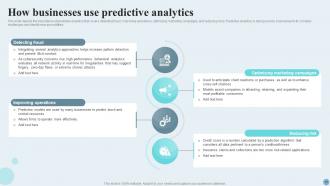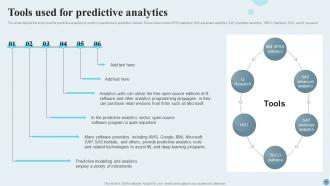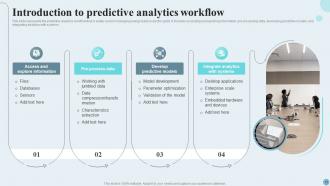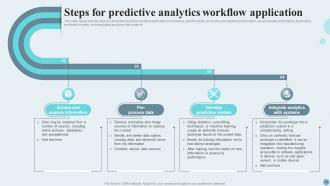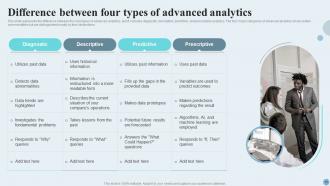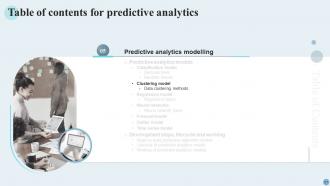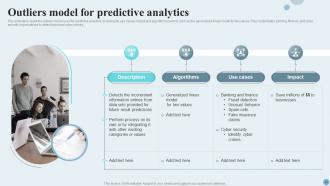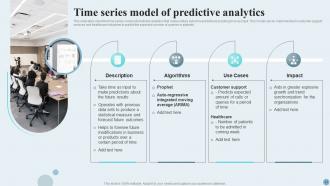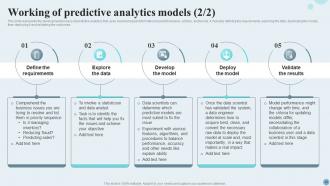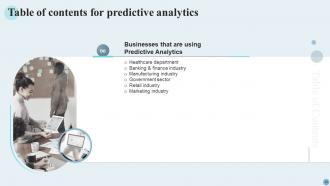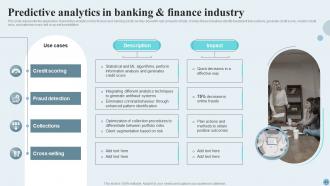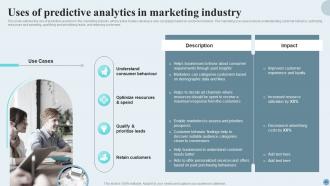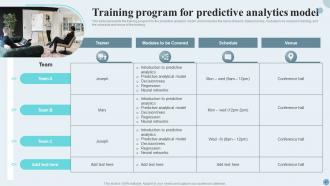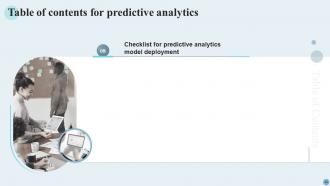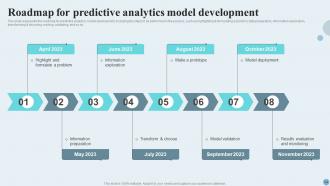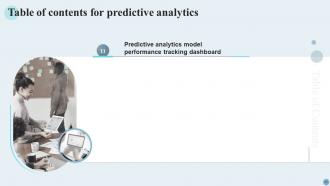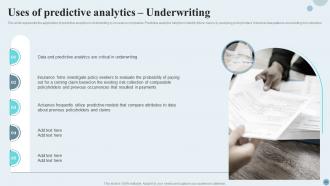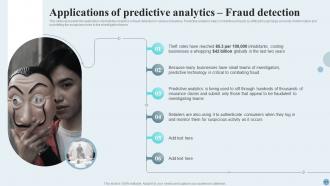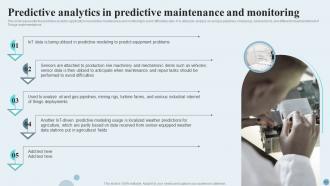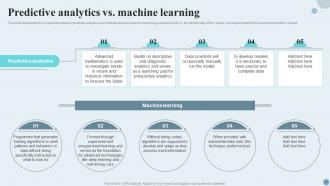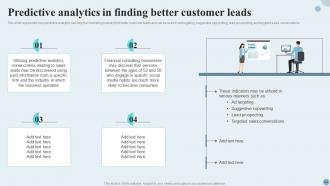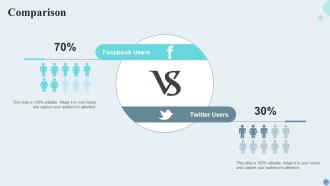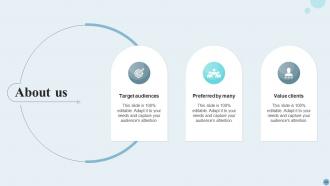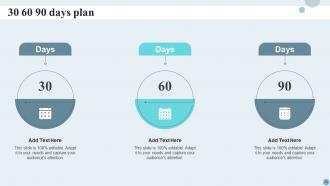Predictive Analytics IT Powerpoint Presentation Slides
Predictive analytics is applicable and valuable to nearly every industry. Check out our efficiently designed Predictive Analytics IT template. It gives a brief idea about predictive analytics, which uses statistical techniques, machine learning algorithms, and other tools to analyze historical data. It also makes predictions about future events or outcomes. In our Predictive Analytics deck, we have covered the introduction to predictive analytics, its framework, and different models. It shows the importance of predictive analytics with its usage. In addition, our Estimation Model PPT exhibits the different predictive analytics tools and their workflow. Further, it covers the difference between the four types of advanced analytics. Our Forecast Model PPT reveals multiple predictive analytics models like classification models, clustering models, etc. Furthermore, it caters to the prominent business sectors that are already using predictive analytics in their daily operations. These include the healthcare department, banking, finance, and many more. Moreover, this Prospective Analysis module comprises a training program and a budget to develop a predictive analytics model. Lastly, it showcases a checklist, a timeline, and a roadmap for predictive analytics model deployment with a performance tracking dashboard. Get access now.
Predictive analytics is applicable and valuable to nearly every industry. Check out our efficiently designed Predictive Ana..
- Google Slides is a new FREE Presentation software from Google.
- All our content is 100% compatible with Google Slides.
- Just download our designs, and upload them to Google Slides and they will work automatically.
- Amaze your audience with SlideTeam and Google Slides.
-
Want Changes to This PPT Slide? Check out our Presentation Design Services
- WideScreen Aspect ratio is becoming a very popular format. When you download this product, the downloaded ZIP will contain this product in both standard and widescreen format.
-

- Some older products that we have may only be in standard format, but they can easily be converted to widescreen.
- To do this, please open the SlideTeam product in Powerpoint, and go to
- Design ( On the top bar) -> Page Setup -> and select "On-screen Show (16:9)” in the drop down for "Slides Sized for".
- The slide or theme will change to widescreen, and all graphics will adjust automatically. You can similarly convert our content to any other desired screen aspect ratio.
Compatible With Google Slides

Get This In WideScreen
You must be logged in to download this presentation.
PowerPoint presentation slides
This complete deck covers various topics and highlights important concepts. It has PPT slides which cater to your business needs. This complete deck presentation emphasizes Predictive Analytics IT Powerpoint Presentation Slides and has templates with professional background images and relevant content. This deck consists of total of seventy two slides. Our designers have created customizable templates, keeping your convenience in mind. You can edit the color, text and font size with ease. Not just this, you can also add or delete the content if needed. Get access to this fully editable complete presentation by clicking the download button below.
Content of this Powerpoint Presentation
Slide 1: This slide introduces the Predictive Analytics (IT). Commence by stating Your Company Name.
Slide 2: This slide depicts the Agenda of the presentation.
Slide 3: This slide incorporates the Table of contents.
Slide 4: This slide highlights the Title for the Topics to be discussed next.
Slide 5: This slide represents the predictive analytics introduction that is used for forecasts action, behaviors, and trends using recent and past information.
Slide 6: This slide outlines the overview of the predictive analytics framework and its components.
Slide 7: This slide depicts the overview of predictive analytics models, including the predictive problems they solve.
Slide 8: This slide elucidates the Heading for the Components to be discussed next.
Slide 9: This slide showcases the importance of predictive analytics in different industries.
Slide 10: This slide presents the importance of predictive analytics that covers detecting fraud, improving operations, optimizing marketing campaigns, etc.
Slide 11: This slide displays the Title for the Ideas to be discussed next.
Slide 12: This slide depicts the tools used for predictive analytics to perform operations in predictive models.
Slide 13: This slide represents the predictive analytics workflow that is widely used in managing energy loads in electric grids.
Slide 14: This slide states the steps for predictive analytics workflow application in industries.
Slide 15: This slide reveals the Heading for the Ideas to be covered further.
Slide 16: This slide shows the difference between the main types of advanced analytics, and it includes diagnostic, descriptive, predictive, and prescriptive analytics.
Slide 17: This slide incorporates the Title for the Components to be discussed next.
Slide 18: This slide describes the overview of the classification model used in predictive analytics.
Slide 19: This slide exhibits the Decision trees technique for classification model.
Slide 20: This slide represents the random forest technique to implement a classification model that simultaneously works on individual subsets of sample data.
Slide 21: This slide portrays the Heading for the Topics to be covered in the following template.
Slide 22: This slide talks about the Predictive analytics clustering model overview.
Slide 23: This slide outlines the two primary information clustering methods used in the predictive analytics clustering model.
Slide 24: This slide portrays the Title for the Topics to be covered further.
Slide 25: This slide represents the regression model of predictive analytics that is most commonly used in statistical analysis.
Slide 26: This slide showcases the types of the regression model, including its overview, examples, and usage percentage.
Slide 27: This slide reveals the Heading for the Components to be discussed next.
Slide 28: This slide depicts the neural networks model of predictive analytics that behave in the same manner as a human brain does.
Slide 29: This slide presents the different types of the neural network model, including their overview, use cases and usage.
Slide 30: This slide indicates the Title for the Ideas to be discussed further.
Slide 31: This slide focuses on the Predictive analytics forecast model introduction.
Slide 32: This slide talks about the outliers model used for predictive analytics, including its use cases, impact and algorithm.
Slide 33: This slide elucidates the Time series model of predictive analytics.
Slide 34: This slide states the Heading for the Components to be covered in the forth-coming template.
Slide 35: This slide discusses the steps required to create predictive algorithm models for business processes.
Slide 36: This slide depicts the lifecycle of the predictive analytics model, and it includes highlighting & formulating a problem, data preparation, etc.
Slide 37: This slide shows the working of predictive analytics models that operates iteratively.
Slide 38: This slide represents the development process of predictive analytics that uses recent and past information to predict behavior, actions, and trends.
Slide 39: This slide contains the Title for the Contents to be discussed next.
Slide 40: This slide outlines the application of predictive analytics in the healthcare department for forecasting the probability of patients having particular medical disorders.
Slide 41: This slide presents the application of predictive analytics in the finance and banking sector as they deal with vast amounts of data.
Slide 42: This slide talks about using predictive analytics in manufacturing forecasting for optimal use of resources.
Slide 43: This slide depicts the usage of predictive analytics technology in the government sector to improve cybersecurity as they are the main drivers of computer technology growth.
Slide 44: This slide represents the application of predictive analytics technology in the retail industry.
Slide 45: This slide elucidates the use of predictive analytics in the marketing industry, where active traders develop a new campaign based on customer behavior.
Slide 46: This slide presents the Heading for the Ideas to be covered further.
Slide 47: This slide represents the training program for the predictive analytics model, and it includes the name of teams, trainer names, modules to be covered in training, and the schedule and venue of the training.
Slide 48: This slide describes the budget for developing predictive analytics model by covering details of project cost summary, amount, etc.
Slide 49: This slide displays the Title for the Ideas to be discussed in the following template.
Slide 50: This slide talks about the checklist for predictive analytics deployment that is necessary for organizations before deploying it and avoiding possible mistakes.
Slide 51: This slide mentions the Heading for the Topics to be covered in the forth-coming template.
Slide 52: This slide depicts the roadmap for predictive analytics model development, including describing the project, information collection, etc.
Slide 53: This slide indicates the Heading for the Contents to be covered in the forth-coming template.
Slide 54: This slide presents the roadmap for predictive analytics model development, including the steps to be performed in the process, such as highlighting & formulating a problem, data preparation, etc.
Slide 55: This slide portrays the Title for the Topics to be discussed in the next template.
Slide 56: This slide reveals the Predictive analytics model performance tracking dashboard.
Slide 57: This slide is used for depicting Additional information.
Slide 58: This is the Icons slide containing all the Icons used in the plan.
Slide 59: This slide describes the usage of predictive analytics in banking and other financial institutions for credit purposes.
Slide 60: This slide exhibit the application of predictive analytics in underwriting by insurance companies.
Slide 61: This slide showcases the Application of predictive analytics in fraud detection in various industries.
Slide 62: This slide represents the predictive analytics application in predictive maintenance and monitoring to avoid difficulties later.
Slide 63: This slide discusses Predictive analytics vs. machine learning.
Slide 64: This slide focuses on Predictive analytics in finding better customer leads.
Slide 65: This slide depicts how predictive analytics help identifies prospects faster in the marketing industry.
Slide 66: This slide reveals the Column chart.
Slide 67: This slide is used for the purpose of Comparison.
Slide 68: This is the About Us slide for showcasing the company-related information.
Slide 69: This slide illustrates the Venn Diagram.
Slide 70: This slide exhibits the 30 60 90 days plan for effective planning.
Slide 71: This slide presents the Roadmap of the firm.
Slide 72: This is the Thank you slide for acknowledgement.
Predictive Analytics IT Powerpoint Presentation Slides with all 77 slides:
Use our Predictive Analytics IT Powerpoint Presentation Slides to effectively help you save your valuable time. They are readymade to fit into any presentation structure.
FAQs
Predictive analytics is a branch of advanced analytics that uses current and historical data to identify patterns and forecast future events, actions, and trends.
The primary components of predictive analytics are data collection, data preprocessing, feature engineering, model selection, model training, model validation, and deployment.
Some common applications of predictive analytics include fraud detection, operations optimization, marketing campaign optimization, healthcare forecasting, finance and banking data analysis, and cybersecurity improvement.
Diagnostic analytics helps to identify the cause of a problem, descriptive analytics focuses on describing the current state of affairs, predictive analytics forecasts future outcomes, and prescriptive analytics recommends actions to achieve a desired outcome.
The steps involved in developing a predictive analytics model include problem formulation, data preparation, feature engineering, model selection, model training, model validation, and deployment.
-
Their professional templates are very impressive, even my manager was curious about the source. I am very grateful.
-
Placing an order on SlideTeam is very simple and convenient, saves you a lot of your time.







